We had arranged to meet Pat for breakfast at the café adjacent to the hotel, but when it hadn’t opened by 7:30 a.m. we decided that we’d better go elsewhere. The most convenient alternative was to buy something from one of the many fast-food places at the transit station, where we were headed anyway. After securing our unneeded luggage in a locker, we found a bakery and bought some pastries and bottled smoothies to consume on the train. Pat wanted something more substantial, so she bought a ham-and-cheese croissant from another food stand across from the bakery. Nancy was very happy with her cardamom bun, and Pat seemed satisfied with her sandwich even though she realized belatedly that it had come from 7-Eleven—a place she had been determined to avoid while in Europe.
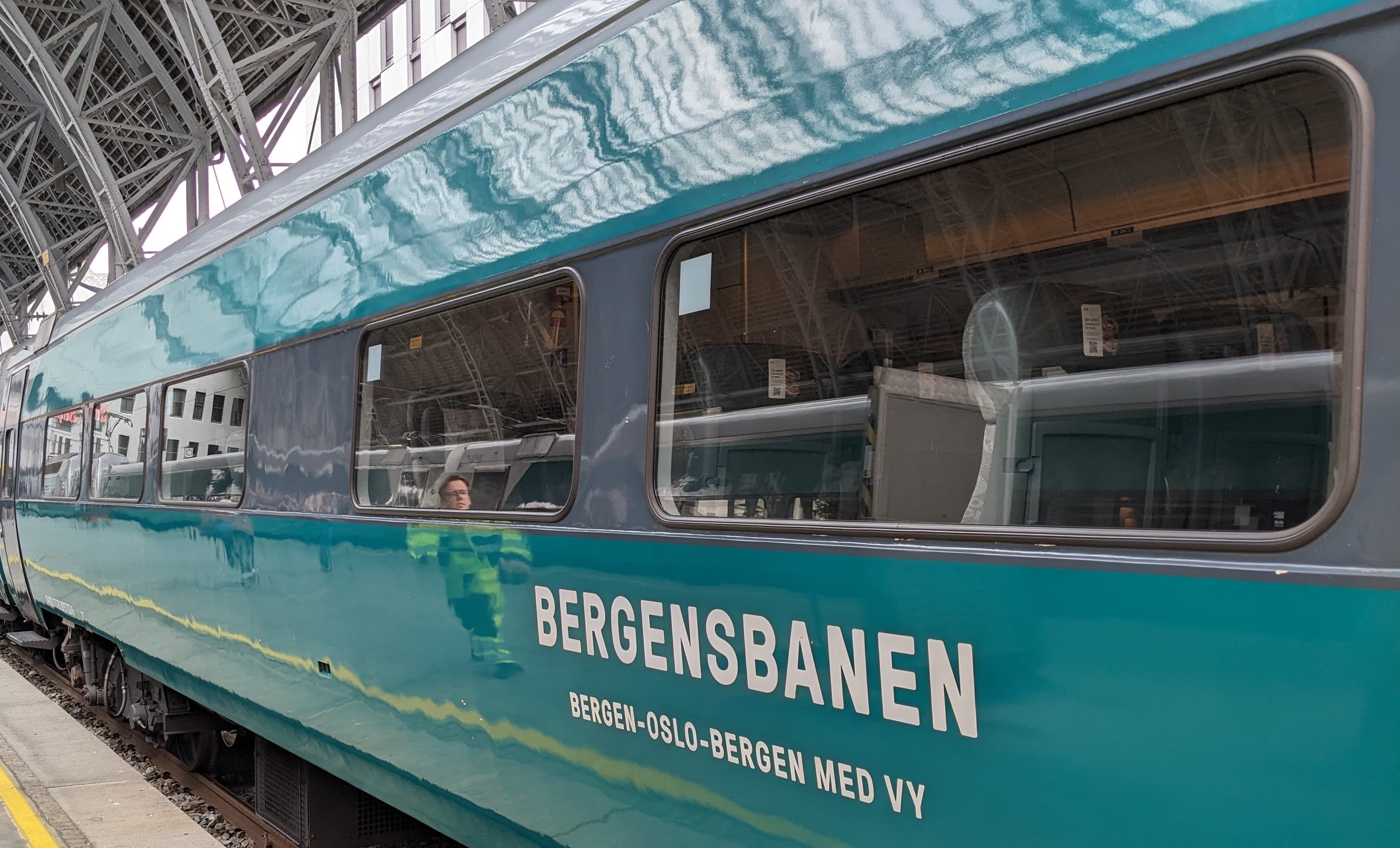
The Bergen Line
The first leg of our Norway in a Nutshell tour was a 485-kilometer (300-mile) rail journey from Oslo to Bergen aboard the Bergensbanen (Bergen Line), part of Norway’s Vy Railway system. Vy is the Norwegian word for view, but it can also mean vista, overview, vision, or even ambition, and the six-and-a-half-hour trip certainly encompassed all aspects of the term. We were a little miffed to discover after we boarded that the Bergensbanen did not have wi-fi; how could a technologically advanced railway system not offer wi-fi during such a lengthy ride? But then we remembered that the point of this excursion was to look out the window, not at our screens, and the natural beauty of the passing scenery more than made up for our loss of contact with the “civilized” world.
Unfortunately, it was nearly impossible to get any good photos of that natural beauty from a train moving at more than 80 kilometers (50 miles) per hour. Nancy tried valiantly, but it seemed that every time the train slowed down enough to take a picture, we would either enter a tunnel or be stuck behind tall trees growing right next to the track. The train did stop occasionally, but only at stations where the view was blocked by the depot. Nancy took a few videos, but decided that trying to condense the expansive landscapes we were seeing into a few seconds just didn’t do them justice. So imagine the following: A brooding sky. Rounded, grass-green hills gradually giving way to rounded, slate-gray mountains splotched with snow. Glaciers in the distance. Hundreds of small bodies of glassy water; a few with one or two small rowboats tied up on shore, but most devoid of anything unnatural. Isolated wooden cottages with no apparent electrical lines. A handful of sheep and cows grazing in small pastures. Occasionally, a village. A few cyclists on a road following the railroad tracks; fewer cars. A river that at some points rushed downhill, creating enough whitewater to challenge the half-dozen kayakers we saw. Curiously, no evidence of ski runs. The terrain could be mistaken for Colorado, but the culture, definitely not.
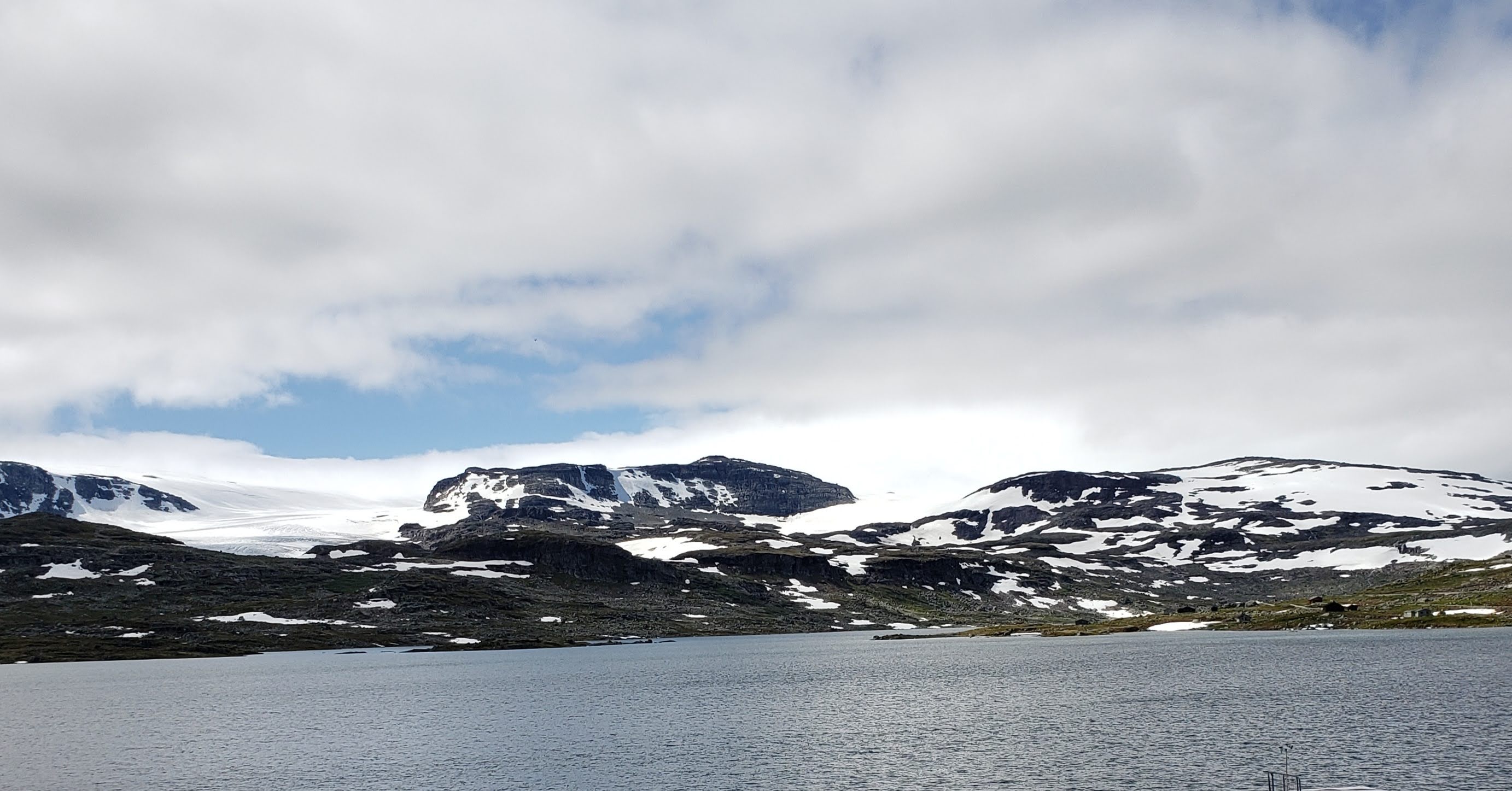 Vista near Finse |
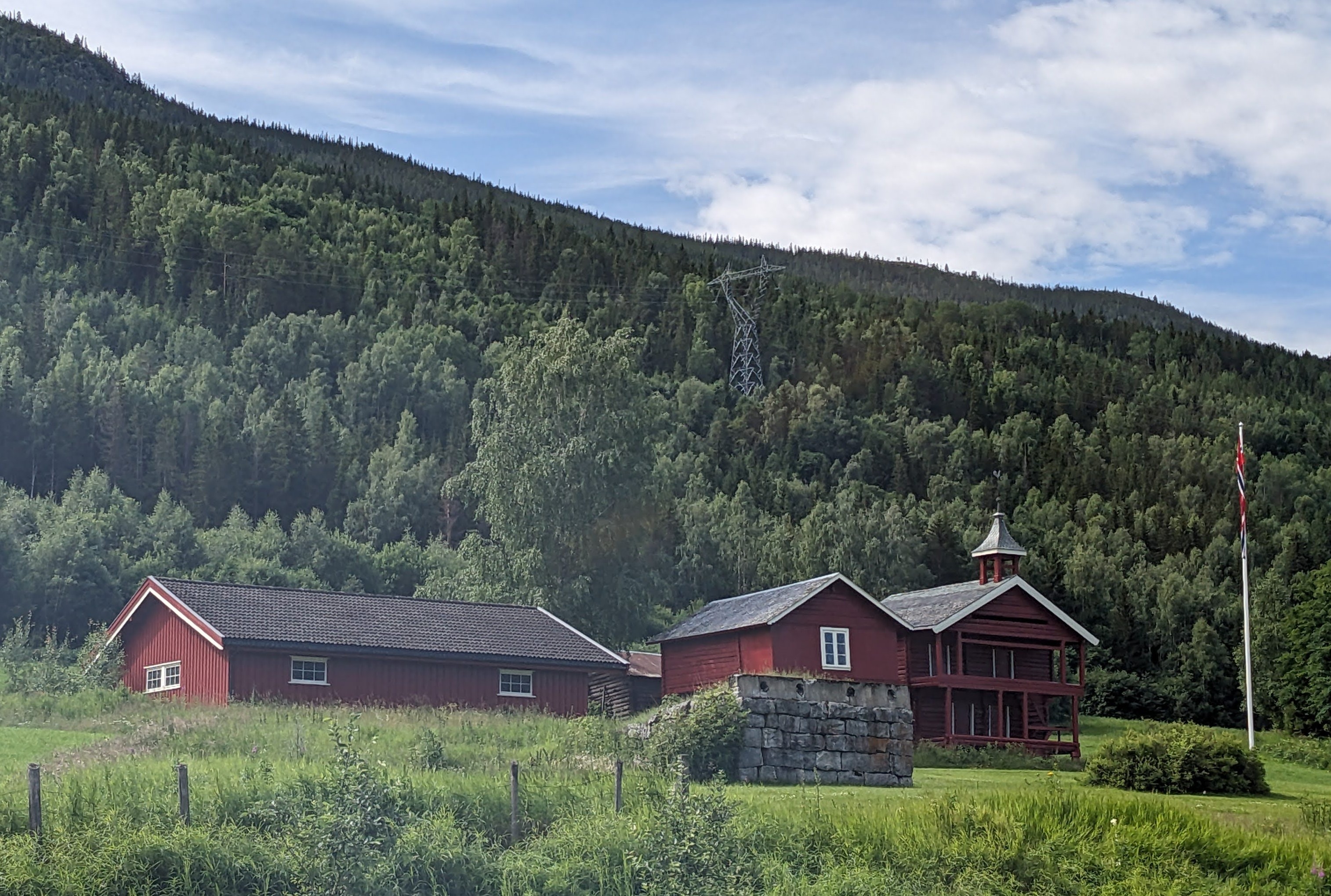 View near Gol |
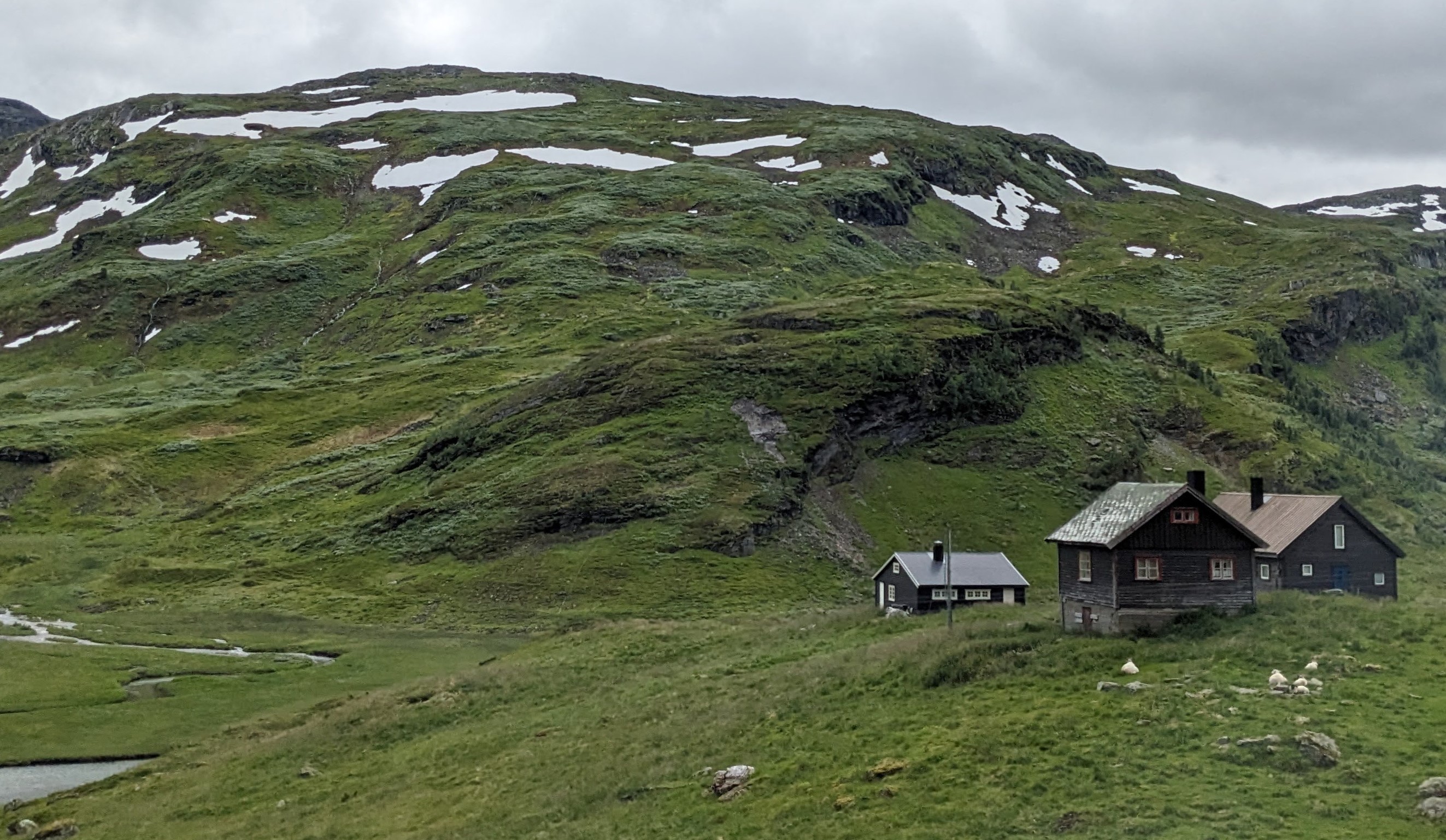 Vision near Upsette |
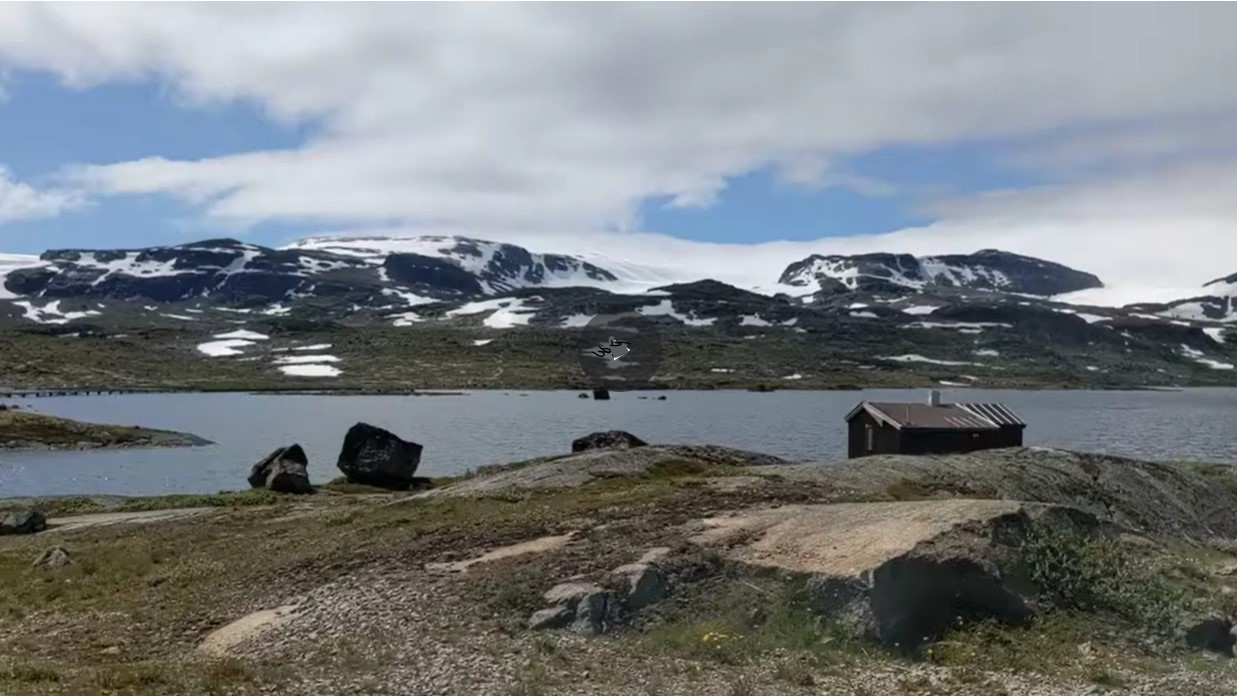 Vista near Ustaoset |
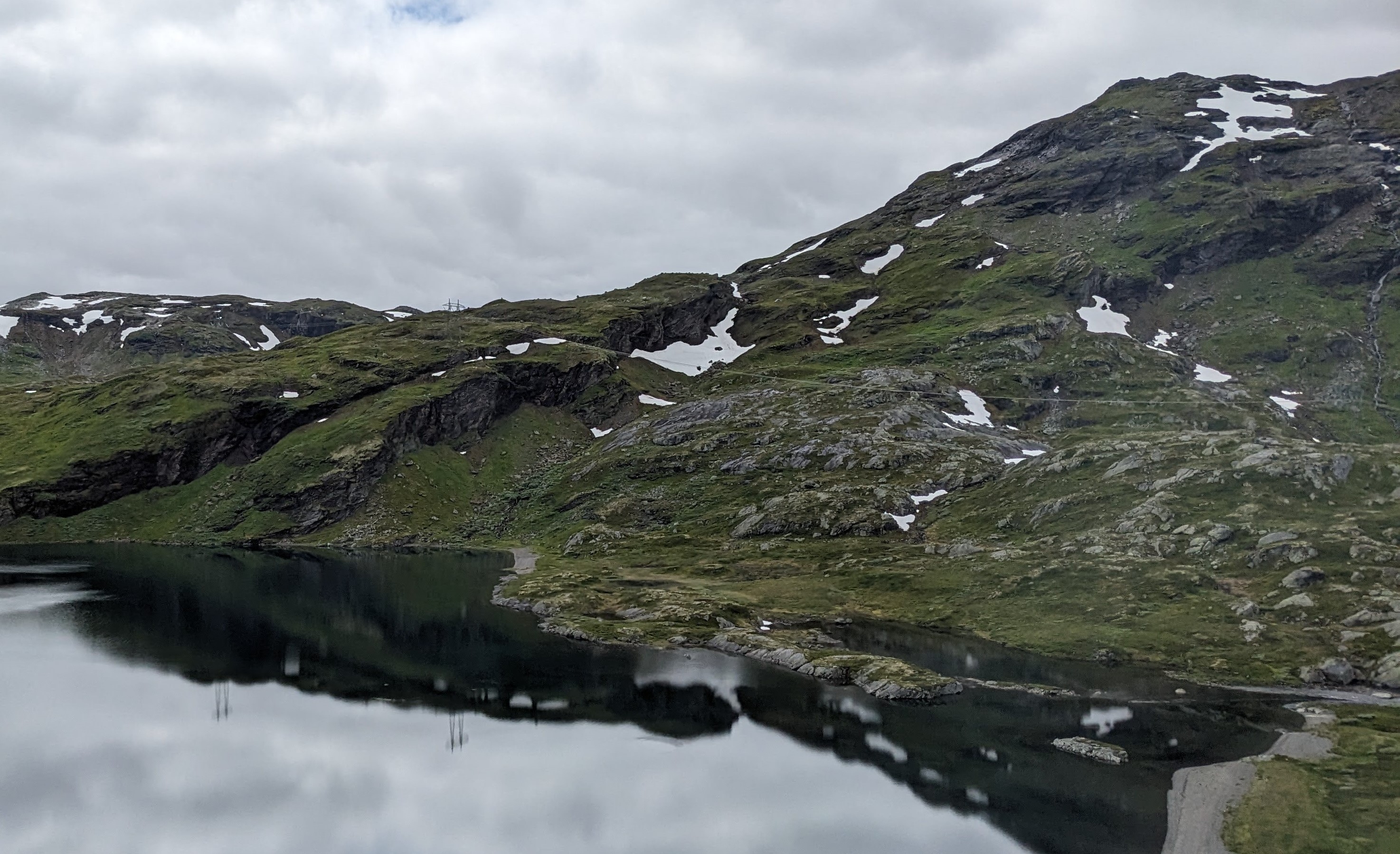 View near Ulvik |
 Vision near Mjølfjell |

Lunch from the onboard café
We arrived in Bergen about 3:15 p.m., having purchased packaged salads on the train for lunch. The walk from the station to the Scandic Hotel was pleasant, skirting Lille Lungegårdsvannet, a small lake in central Bergen. The lake, bounded by a neat, octagonal concrete coping and surrounded by a well-manicured park, looks man-made but isn’t. In previous centuries the lake was much larger and connected to the North Sea through a nearby bay, but as the city grew, builders filled in the marshy land around the lake’s margins, and it shrank. Lille Lungegårdsvannet is still fed by brackish seawater from the bay via a system of underground pipes, so the water level shifts with the tides. Art museums and galleries, including one devoted to the work of Edvard Munch, line the southwest shore of the lake.
 Bergen train station |
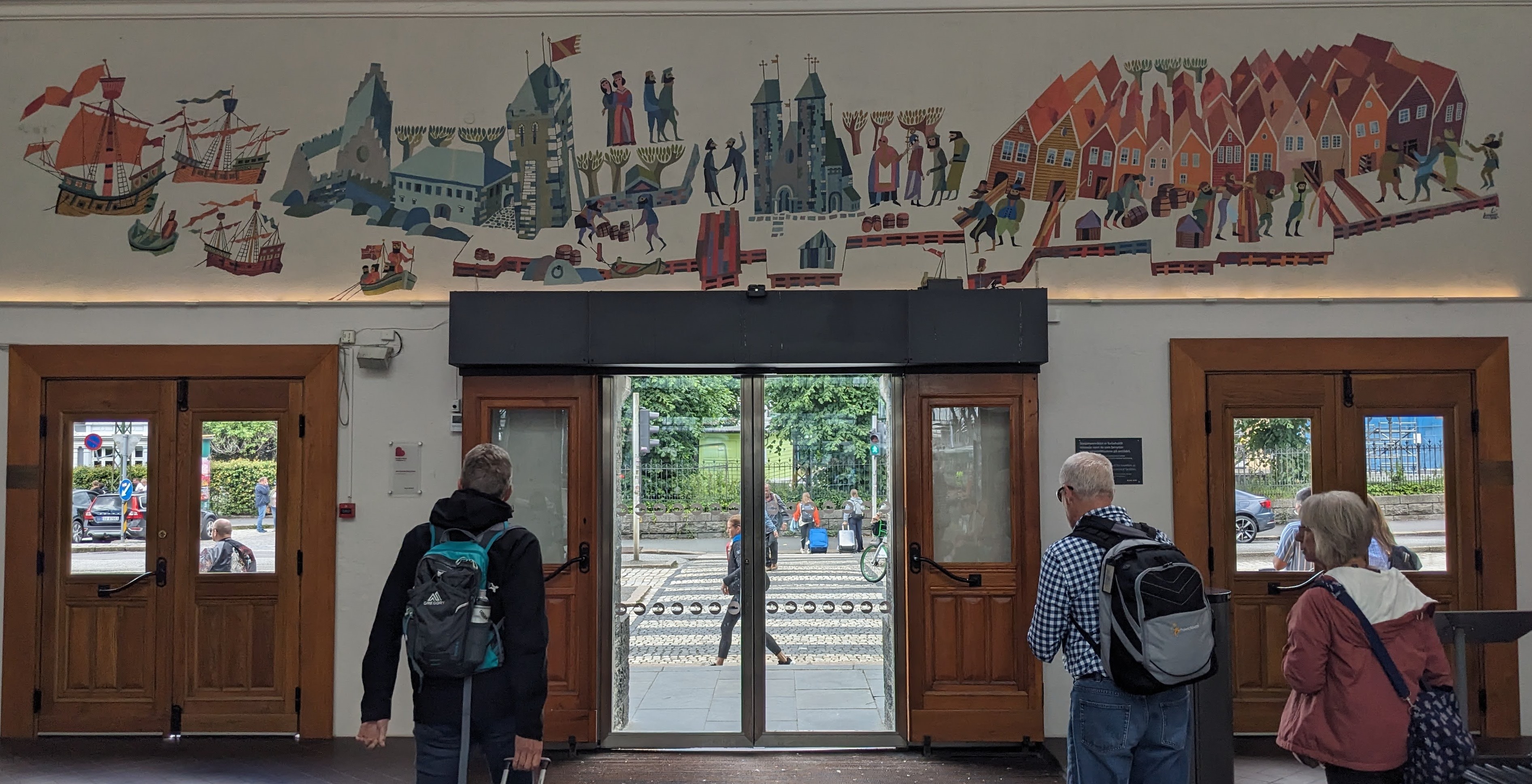 Mural inside the Bergen train station |
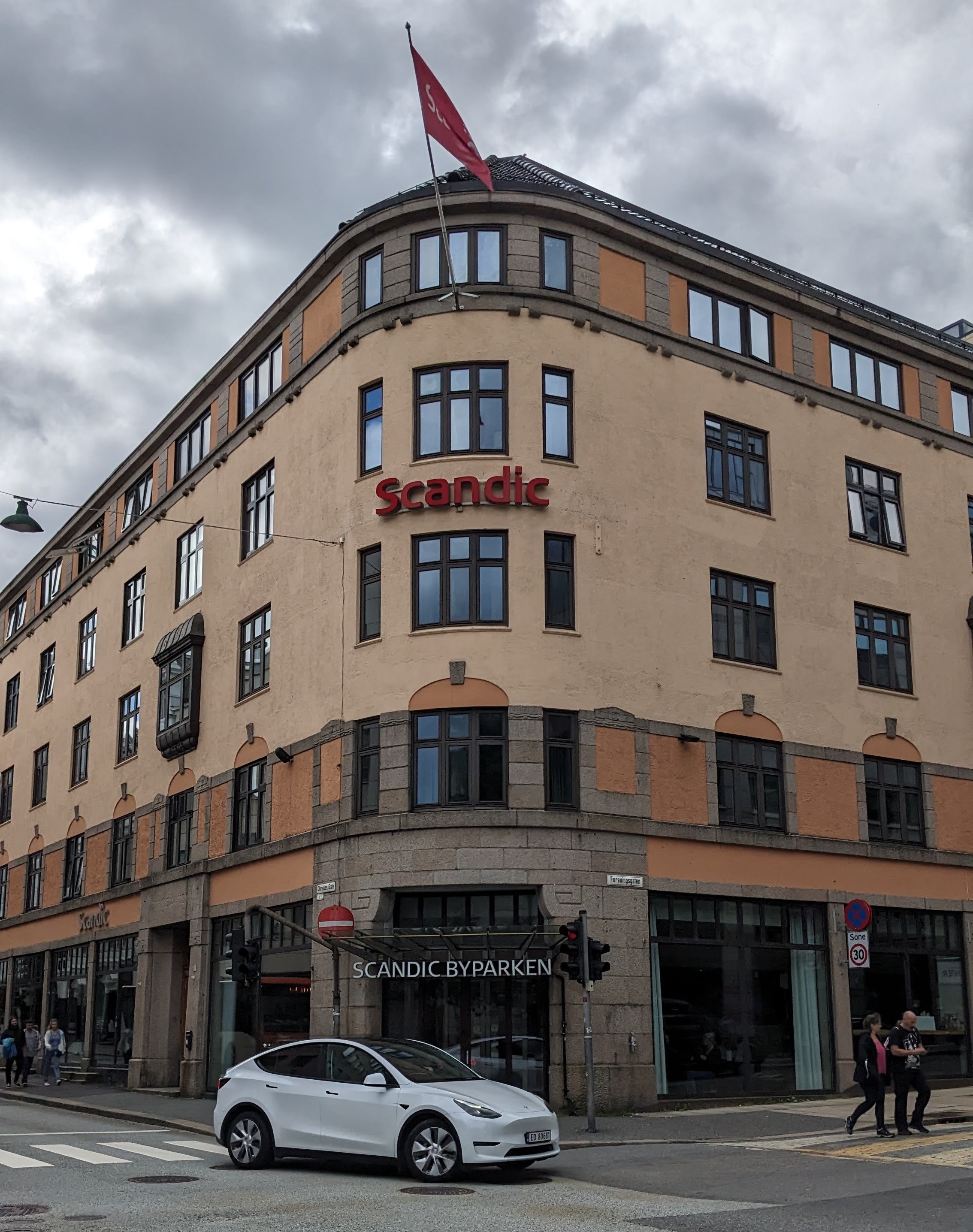 Scandic Byparken Hotel |
 Lille Lungegårdsvannet |
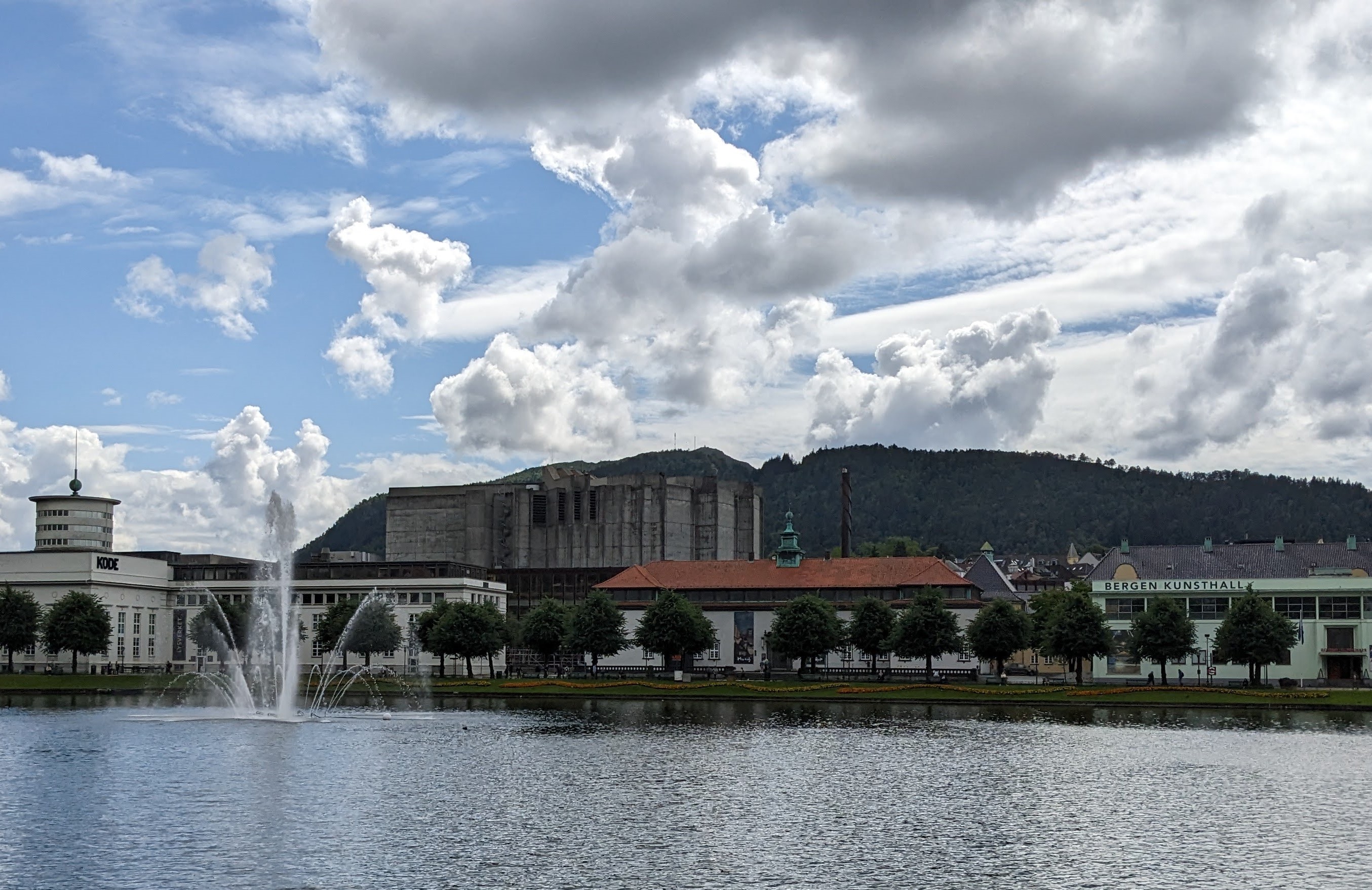 Museums line the southwest shore of the lake |
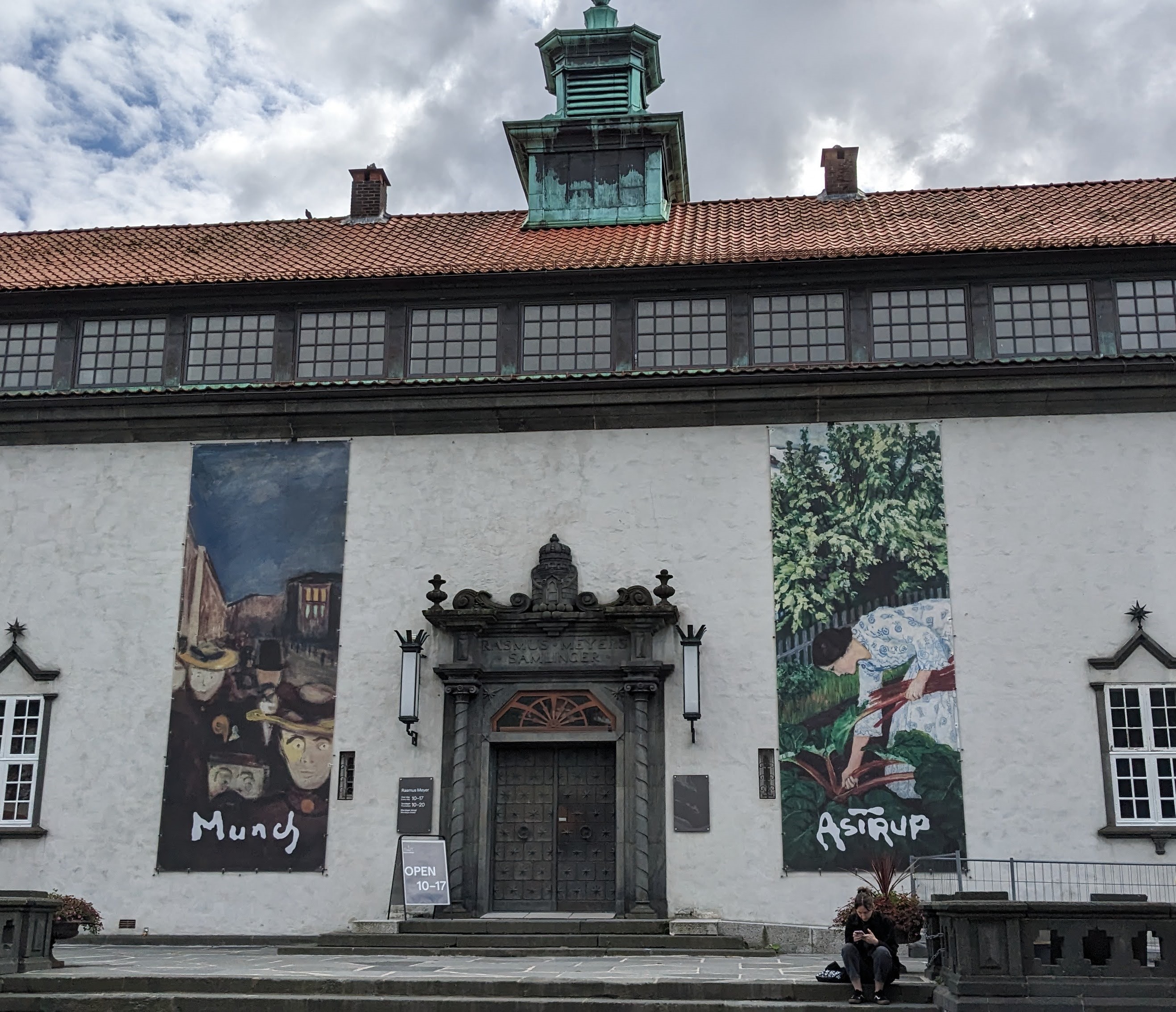 Kode 3 art museum |
After checking into our rooms, we went out for a self-guided walking tour that Michael had cobbled together with information gleaned from various websites. We’re not sure exactly how many “Nutshell” tourists had arrived in town on the Bergensbanen, but there seemed to be a lot of other people relaxing in the park or leisurely wandering through the picturesque streets that afternoon. Dramatic clouds filled the sky, but the forecast rain never materialized.
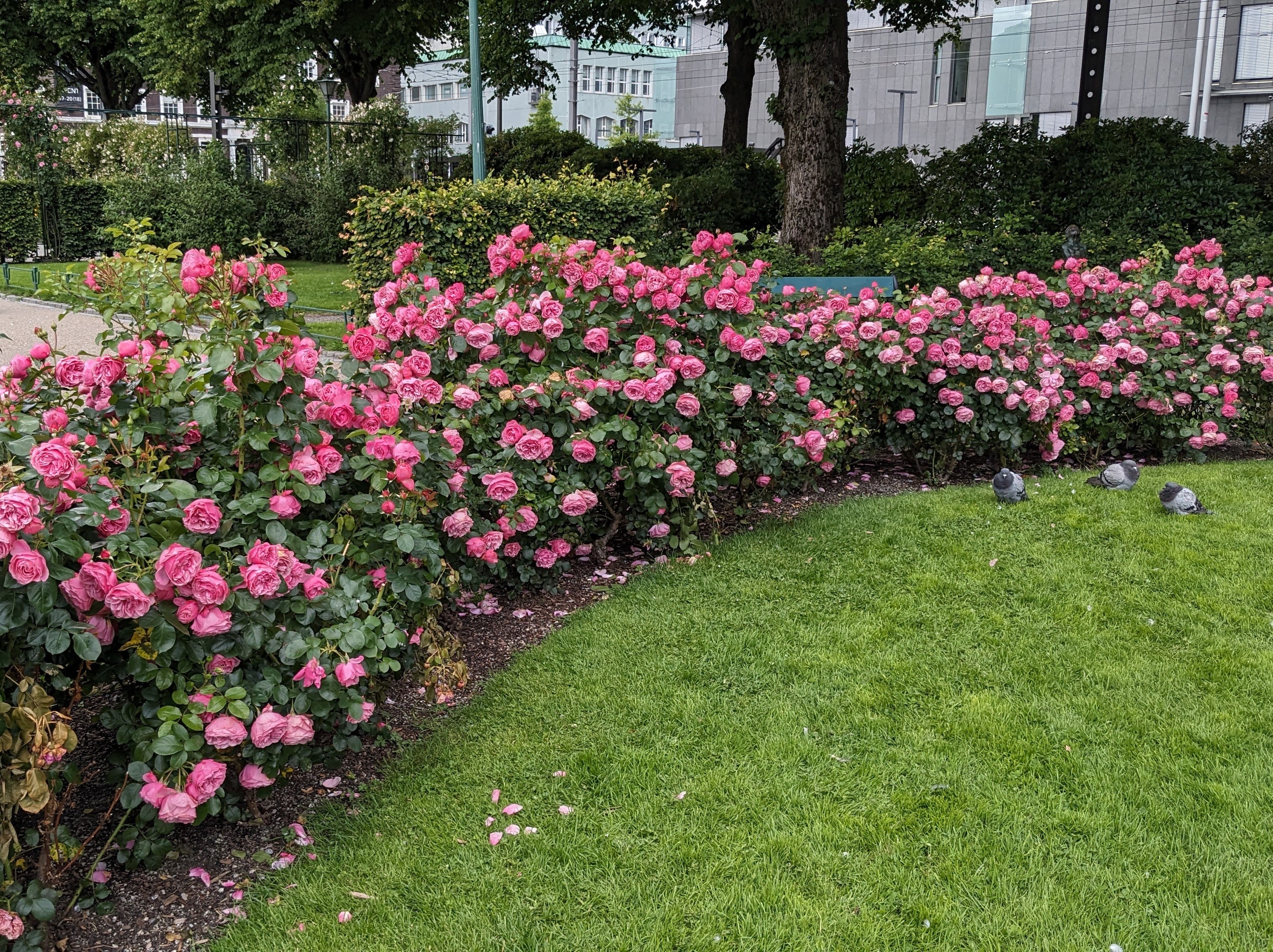 Rose garden |
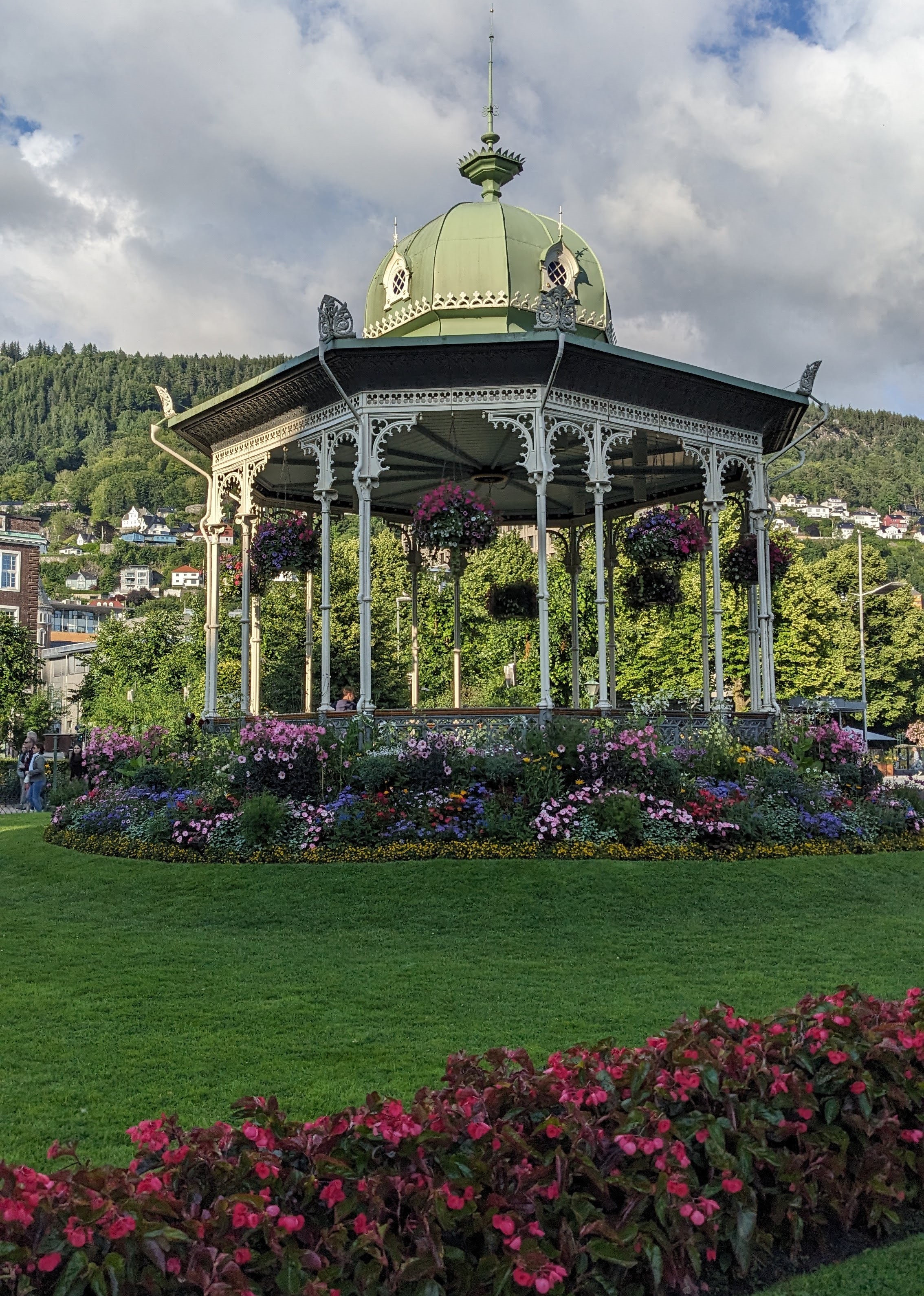 Byparken (City Park) gazebo, center of Bergen’s Christmas market and other festivals |
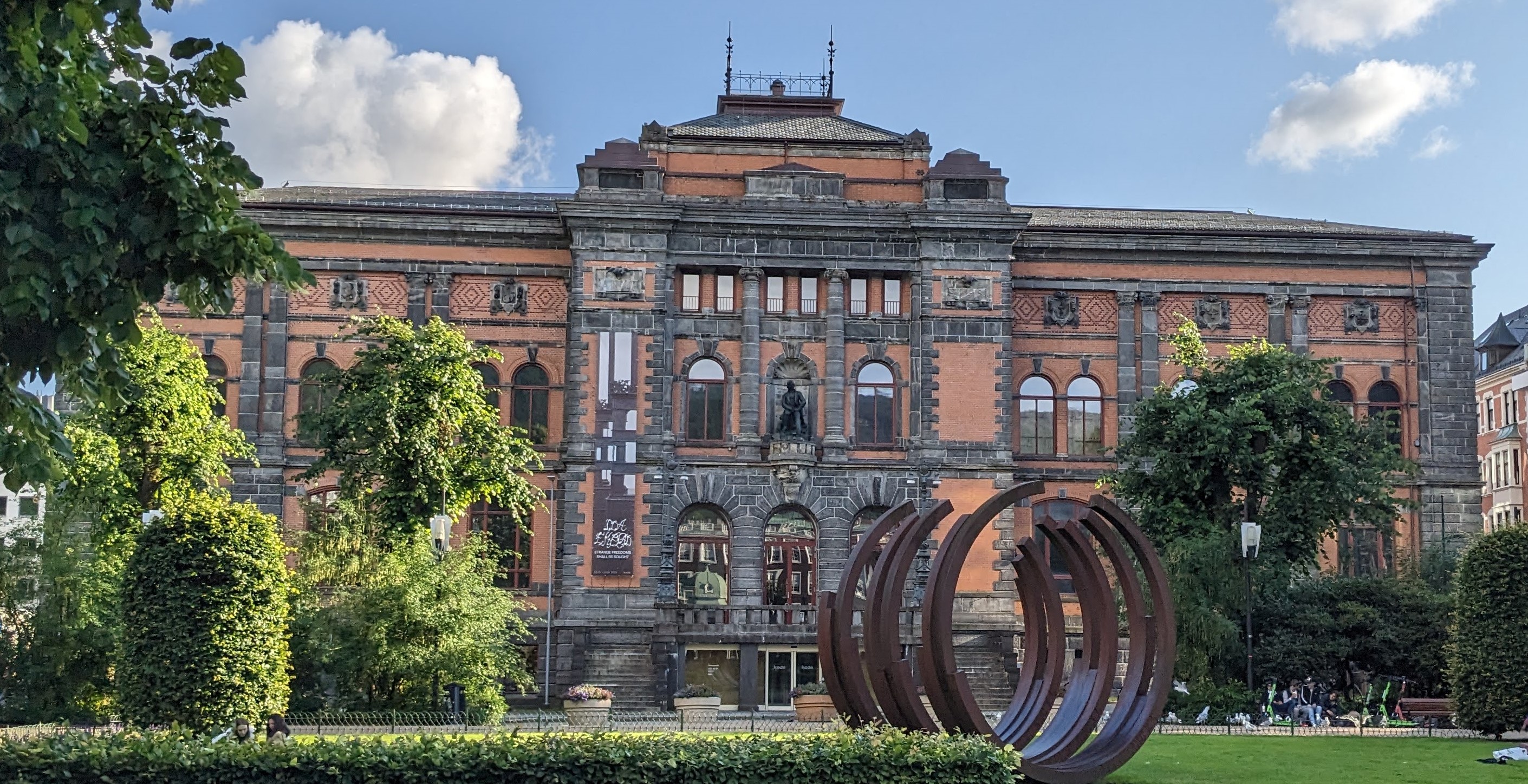 Museum of Decorative Arts |
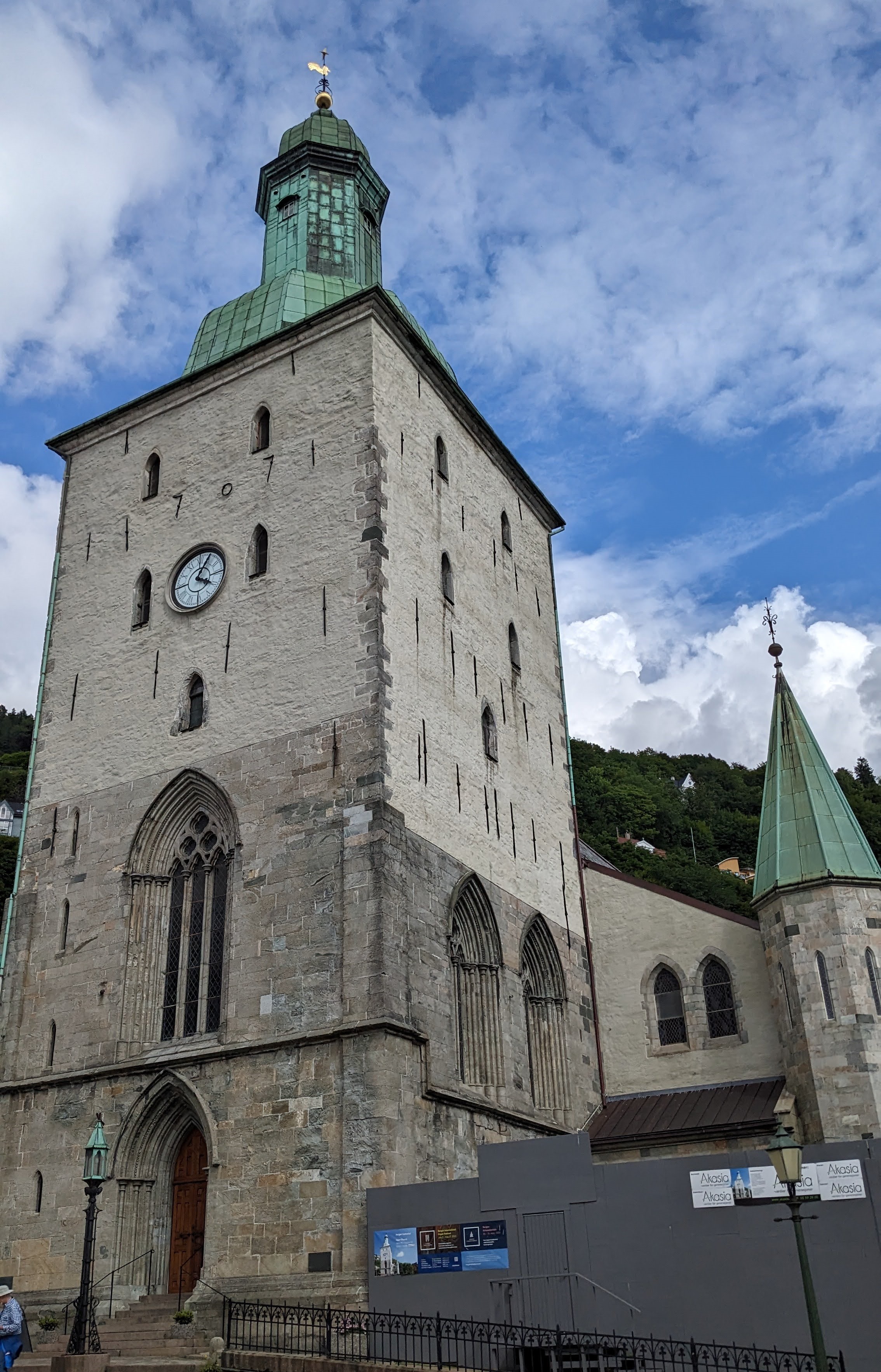 Bergen Domkirke |
 Typical narrow Bergen street: Lille Øvregaten |
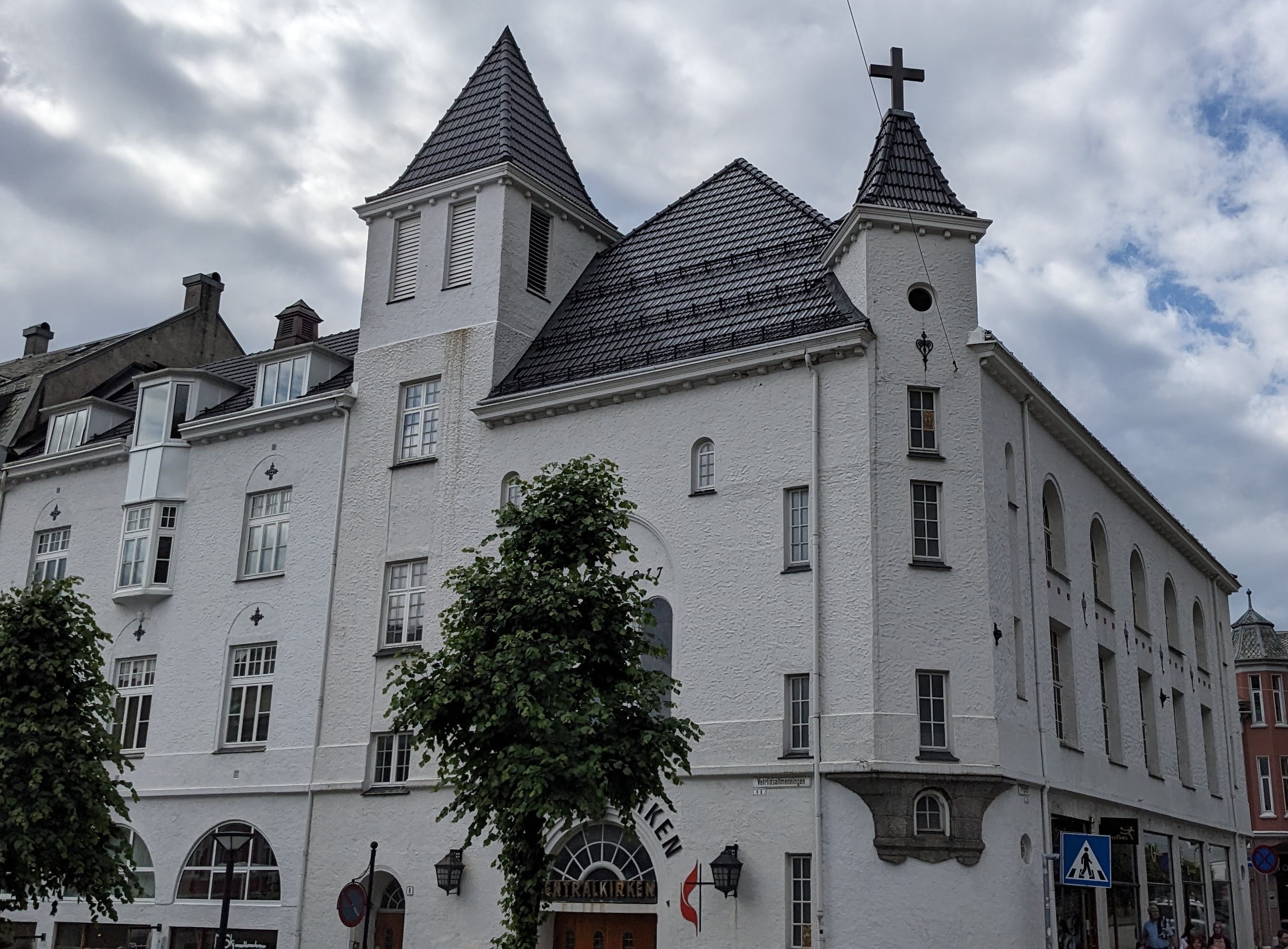 Central Bergen Methodist Church |
Michael led the way uphill to the Fløibanen, a funicular that carries passengers to the top of Mount Fløyen for spectacular views of Bergen and its harbor. Mount Fløyen also features a herd of cashmere goats, kept there not for their wool but to keep the natural vegetation in check.
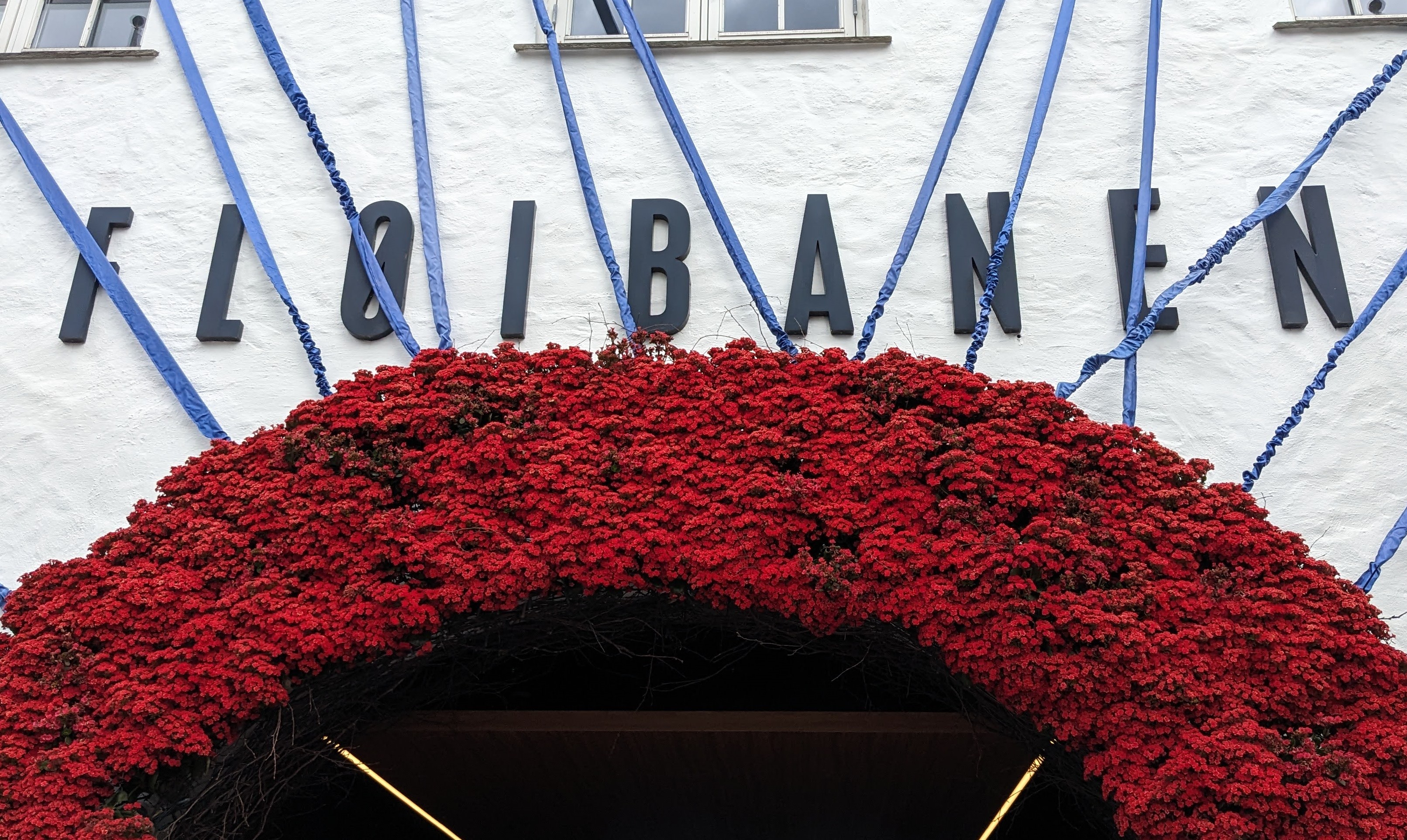 Funicular entrance |
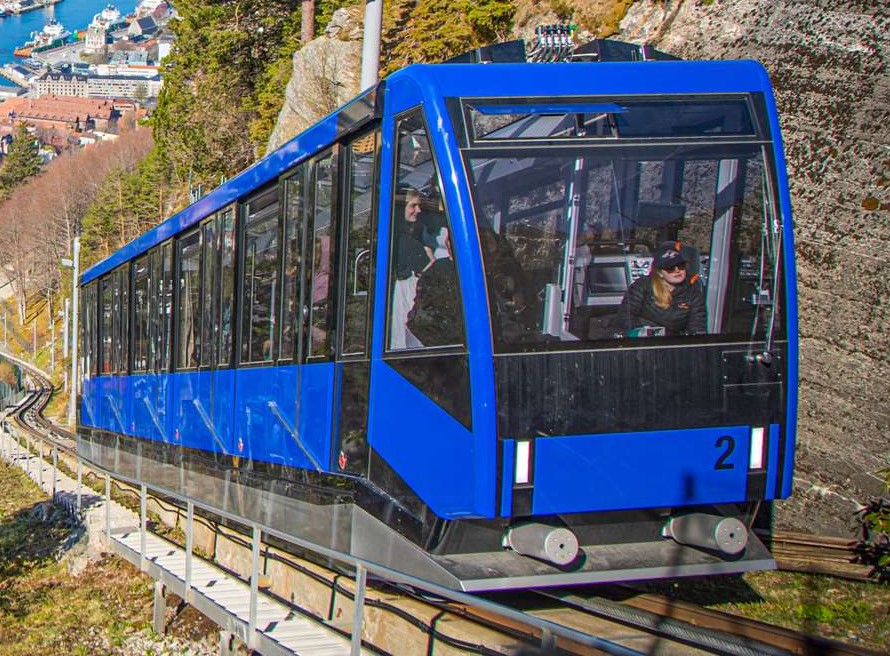 Fløibanen |
 Pat and Michael riding the furnicular |
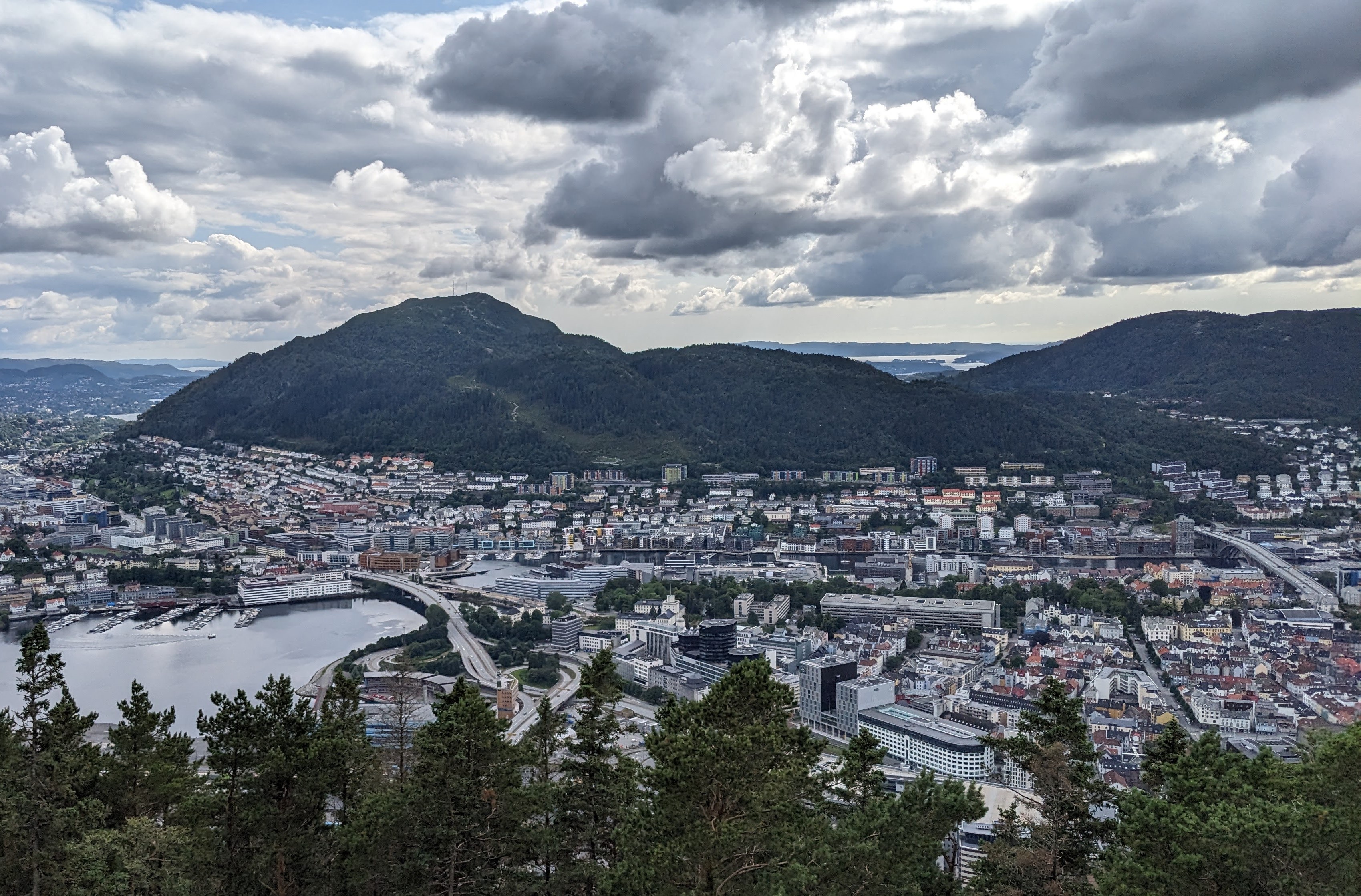 View of Bergen from Mount Fløyen |
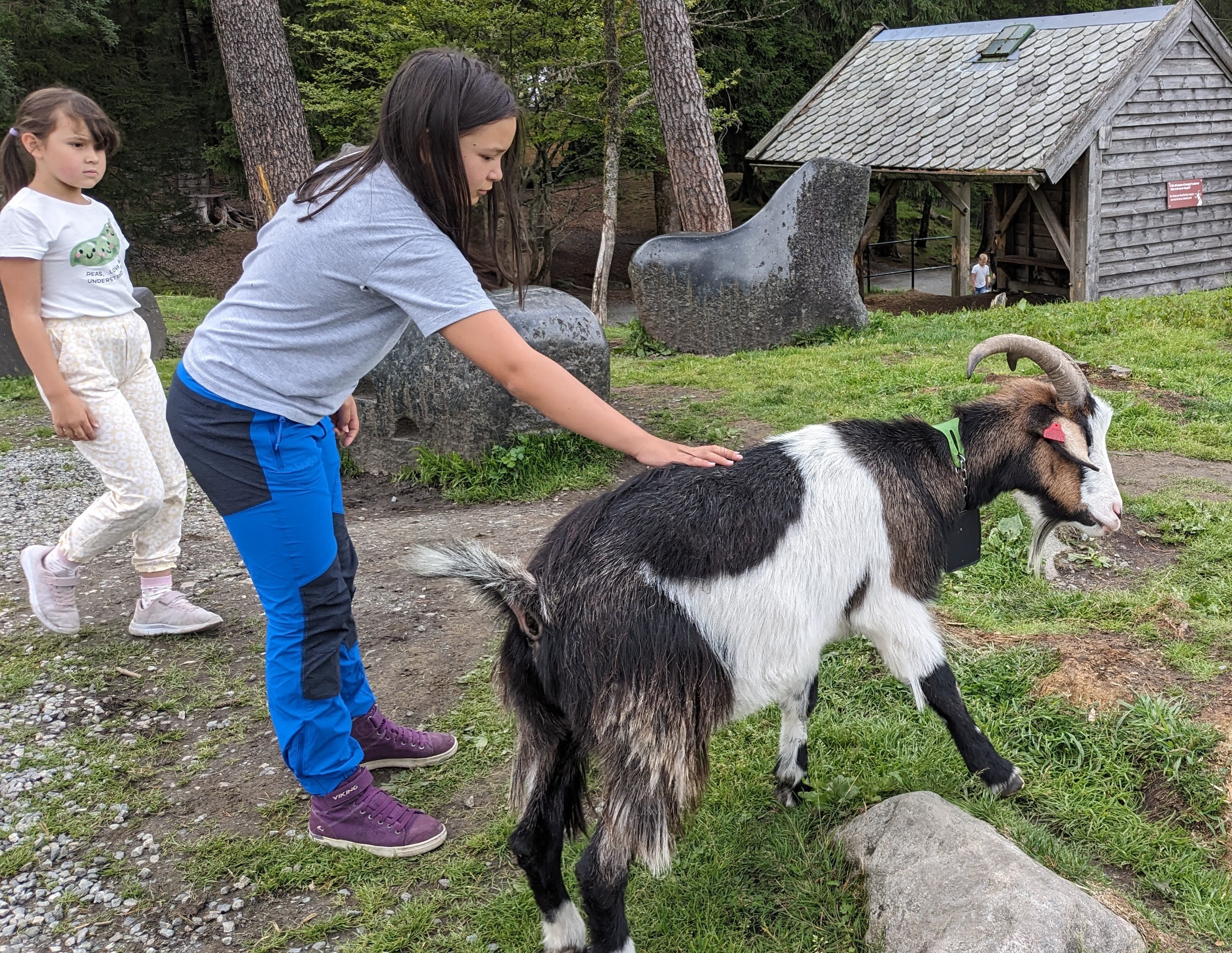 One of Fløyen’s friendly goats |
A five-minute walk took us from the funicular station to Bryggen, Bergen’s bayside wharf district. This was an important North Sea port for centuries, especially in the days of the Hanseatic League, a merchant organization that established a major trading center here in 1350. Now recognized as a UNESCO World Heritage Site, Bryggen’s historic buildings are undergoing conservation. Unfortunately, none of the original wooden structures were accessible during our visit, but we could peek into the windows of shops in restored buildings along the waterfront. We also explored the remains of the Norwegian Royal Castle that once guarded the entrance to the port, which included Rosenkrantztårnet (a watchtower that dates from 1270) and the watchmen’s residence (1728).
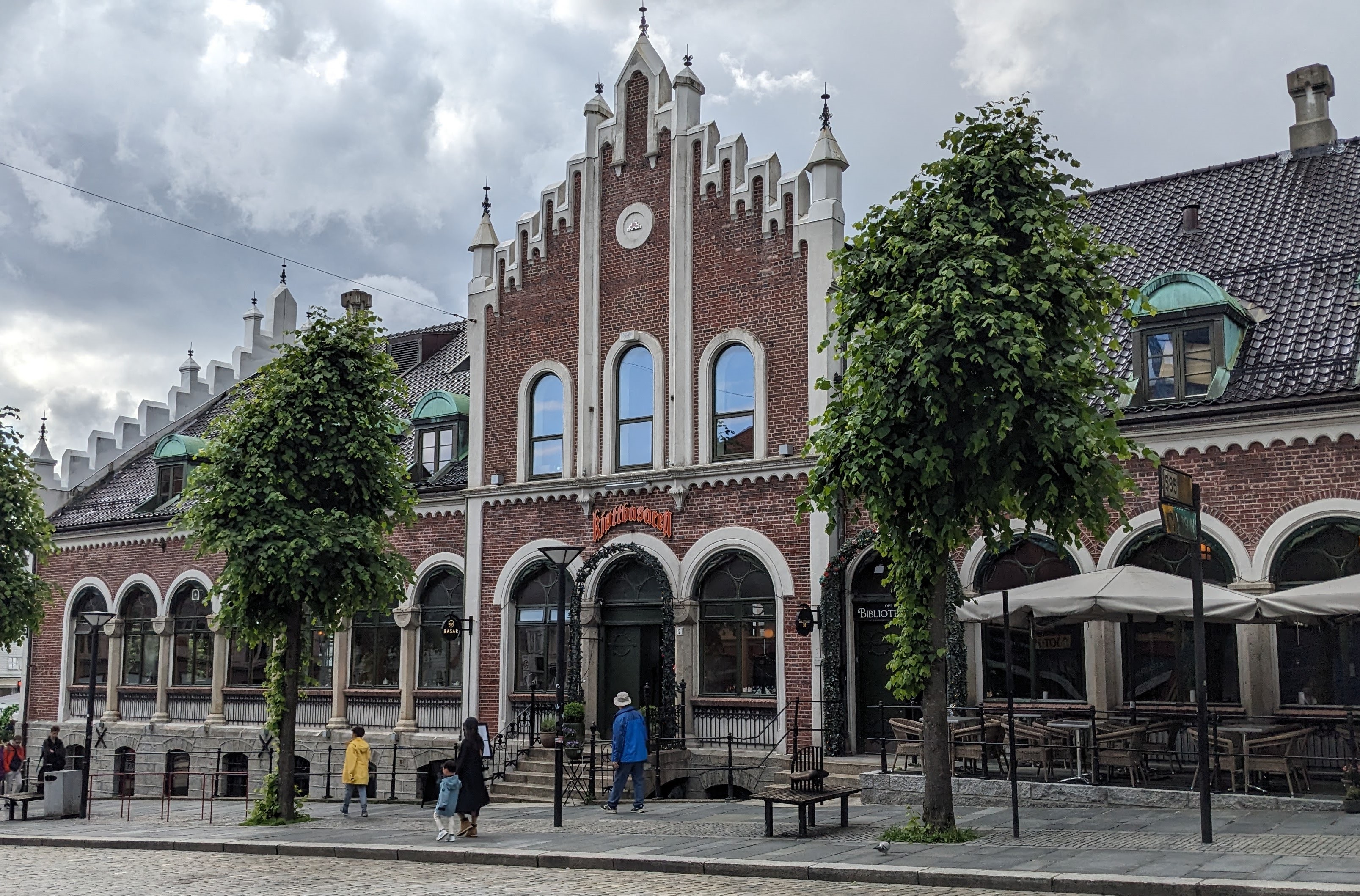 Kjottbasaren Market formerly sold only meat, but now offers a variety of foods |
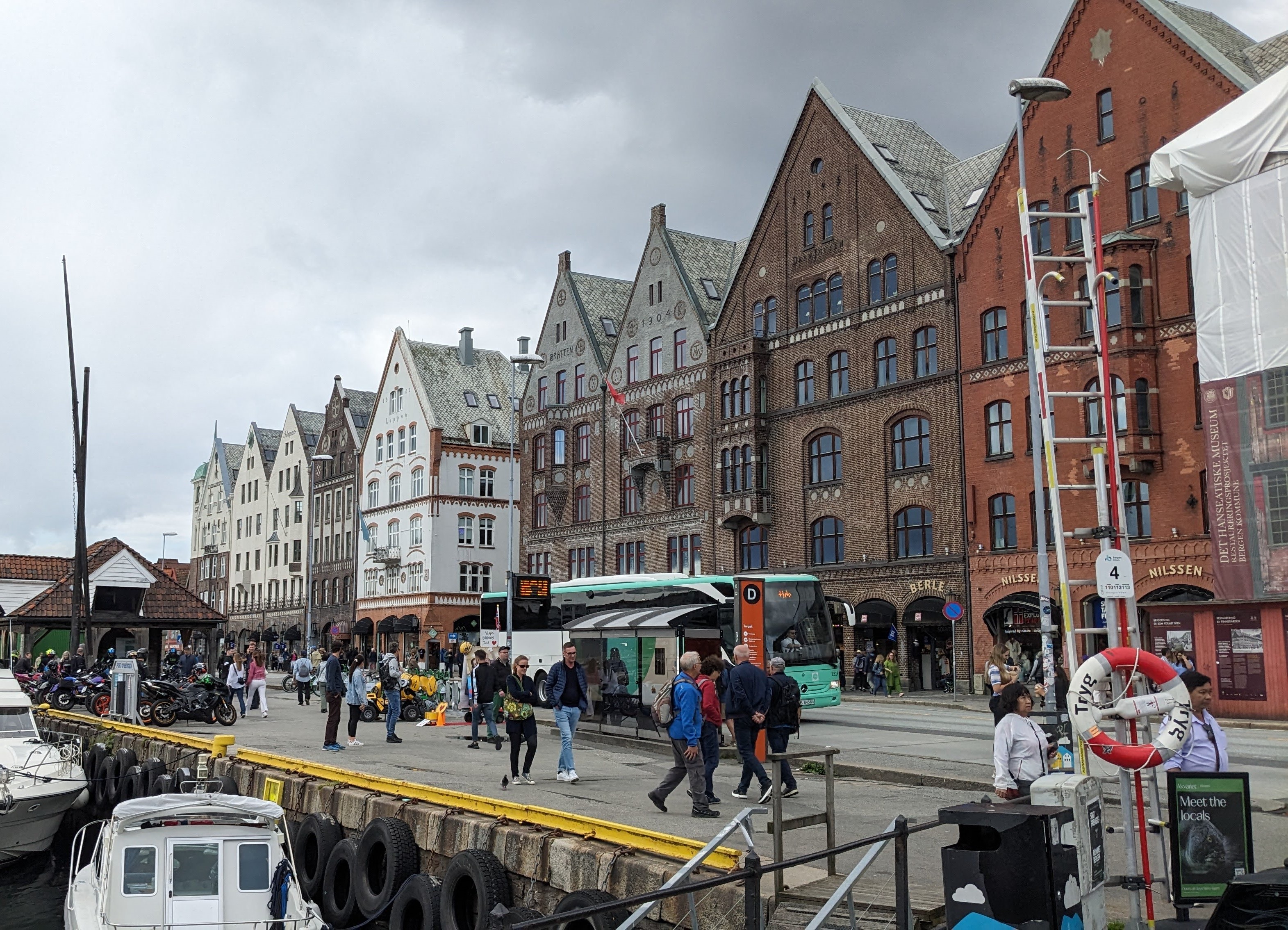 Bryggen (The Wharf) |
 Bryggren shops |
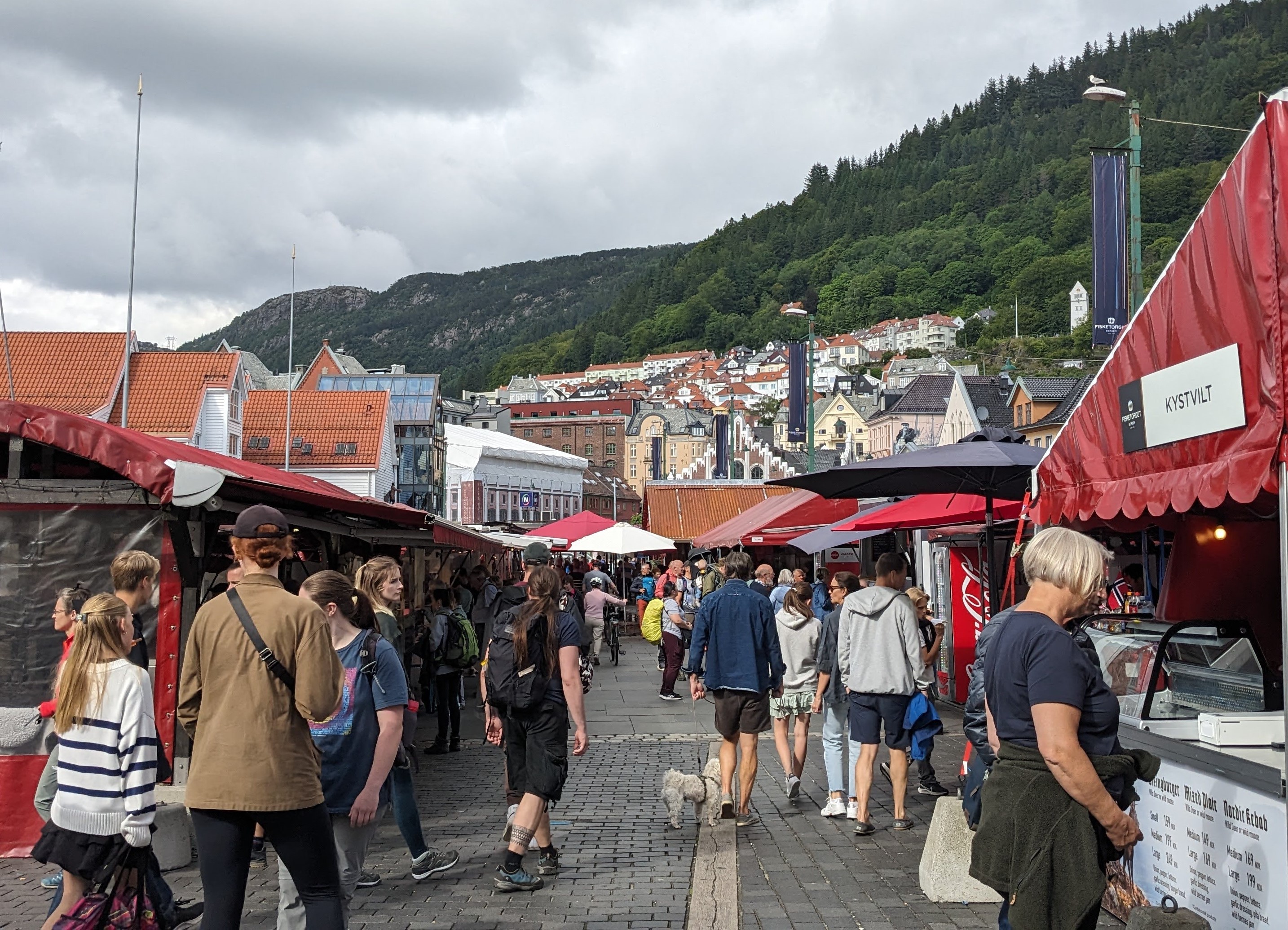 Fish Market |
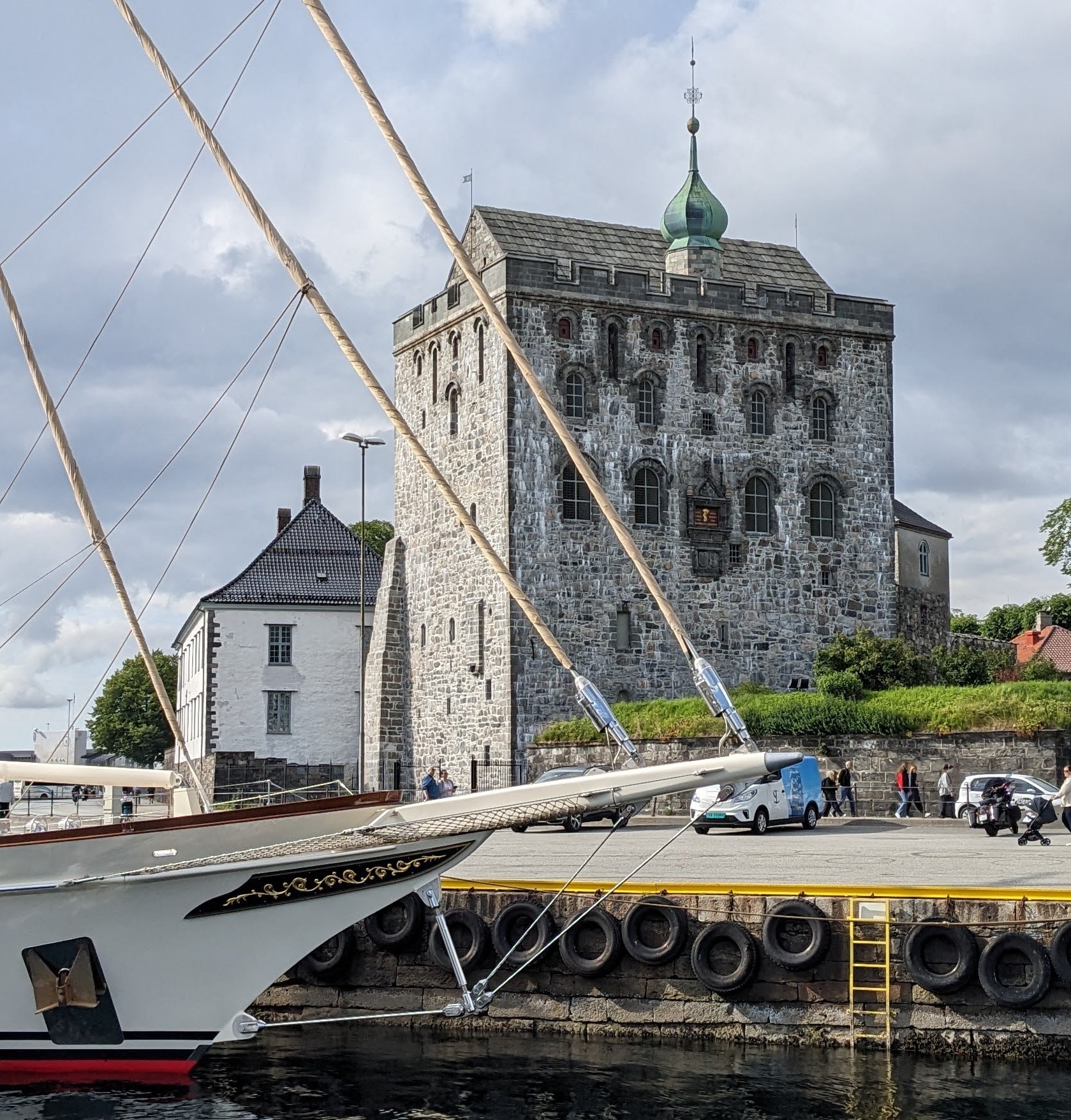 Rosenkrantztårnet, 1270 |
 Kapteinvaktmesterbolingen (residence of the captain of the watchmen), 1728 |
The wharf is still bustling, and the open-air fish market offered lots of choices for dinner. Michael and Pat shared a combination platter from the Seaside Grill that included shrimp, scallops, and salmon, but Nancy was drawn to a nearby vendor making “Nordic kebabs” filled with slivers of grilled reindeer and moose meat. (Though we could have ordered one, none of us wanted to try a whole whale steak.) We stopped for ice cream on our way back to the hotel. Everything we ate was wonderful!
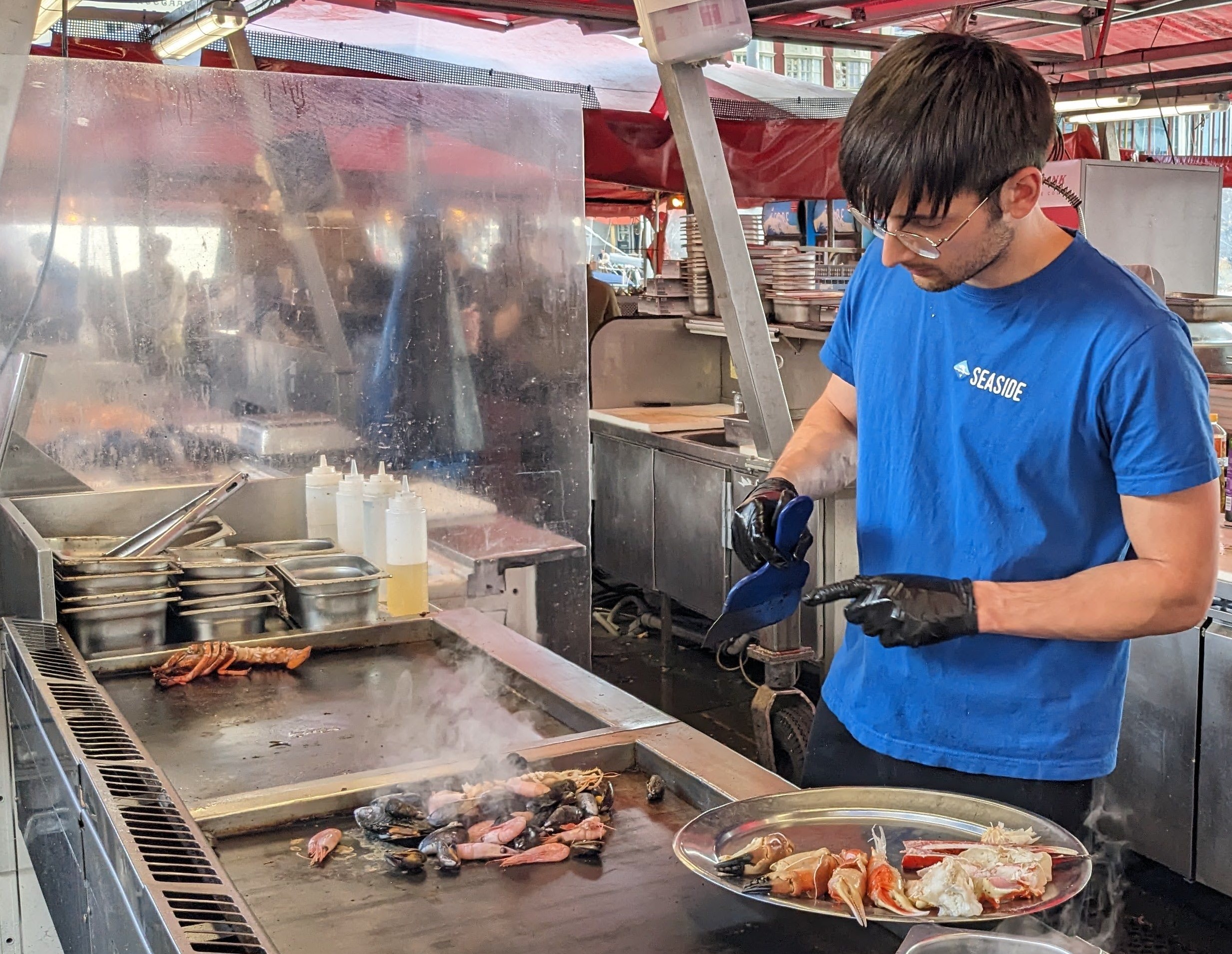 Chef at the Seaside Grill |
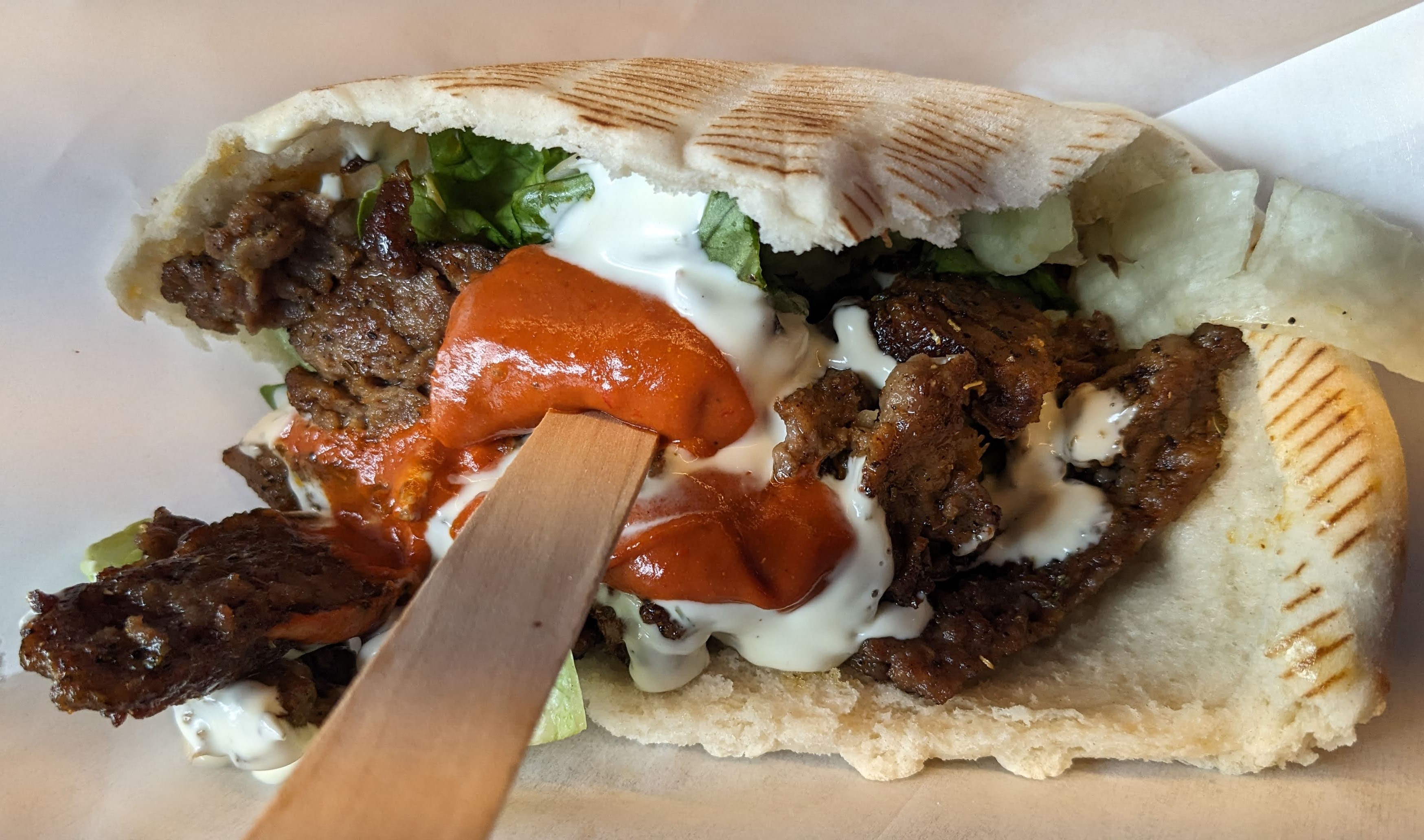 Nancy’s Nordic Kebab |
 Nordic Kebab fillings on the grill |
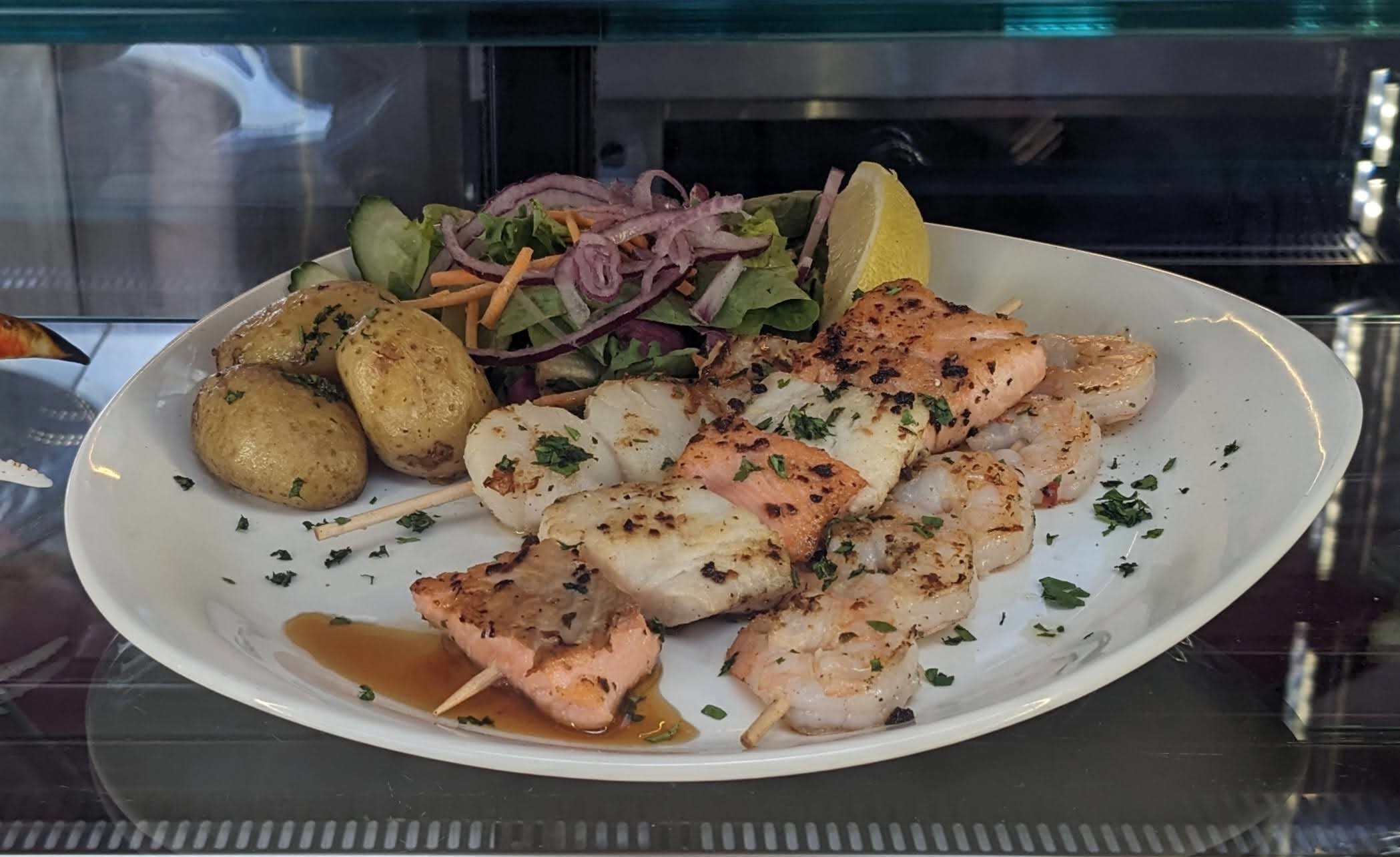 Michael and Pat shared a seafood combo platter |
 Pat and Michael at the open-air Seaside Grill |
 Ice cream at Byantikvaren Hallsien |
As had occurred the previous night in Oslo, Pat decided to stay at the hotel while Nancy and Michael went back out to complete our walking tour. We strolled past the Bergen National Theatre, where the current production appeared to be a satirical comedy in the same vein as “Springtime for Hitler” (the wacky musical featured in The Producers), and then sought out a few statues depicting local historical figures. One stood atop a fountain in a pedestrian plaza near the city park: it honors Ole Bull, a nineteenth-century virtuoso violinist who was born in Bergen. He became a soloist with the city’s Philharmonic Orchestra when he was only nine years old and went on to a career as a noted performer, composer, and champion of Nordic music. A sculpture at the base of the same fountain depicts a skald, one of an order of ancient poets who sang the praises of Viking kings and warriors. This one is playing a harp. At one end of Torgallmenningen, Bergen’s main street, we examined the Sjømannsmonumentet (Sailors Monument), dedicated to Bergen’s seafarers and showing how their functions—and costumes—had evolved from the Viking era to the twentieth century. The sculptor, Dyre Vaa (whose name Google translates amusingly as “Expensive Wow”), started the project in 1939 and worked on it all during World War II, using local men as models for the twelve figures.
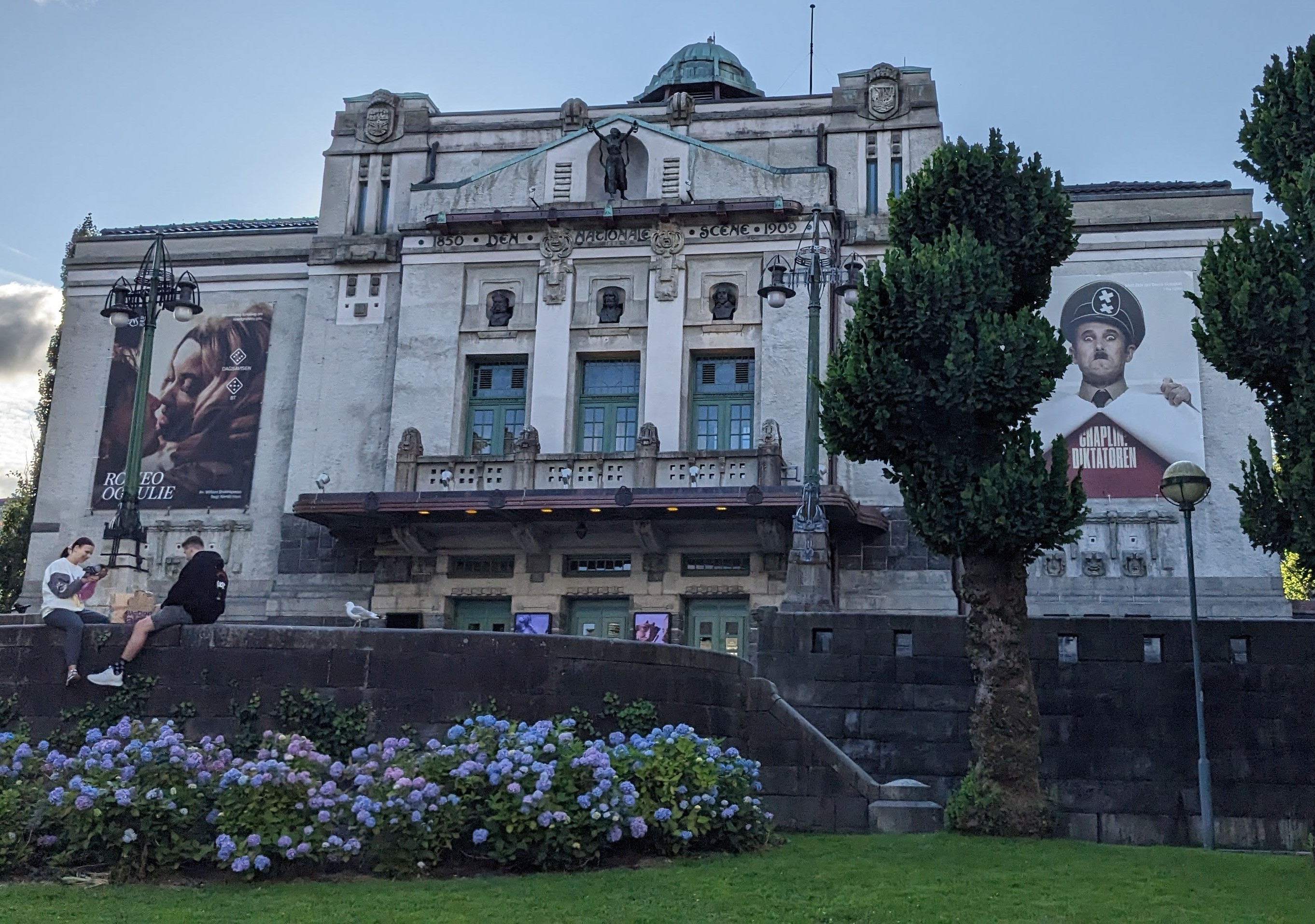 Bergen National Theatre |
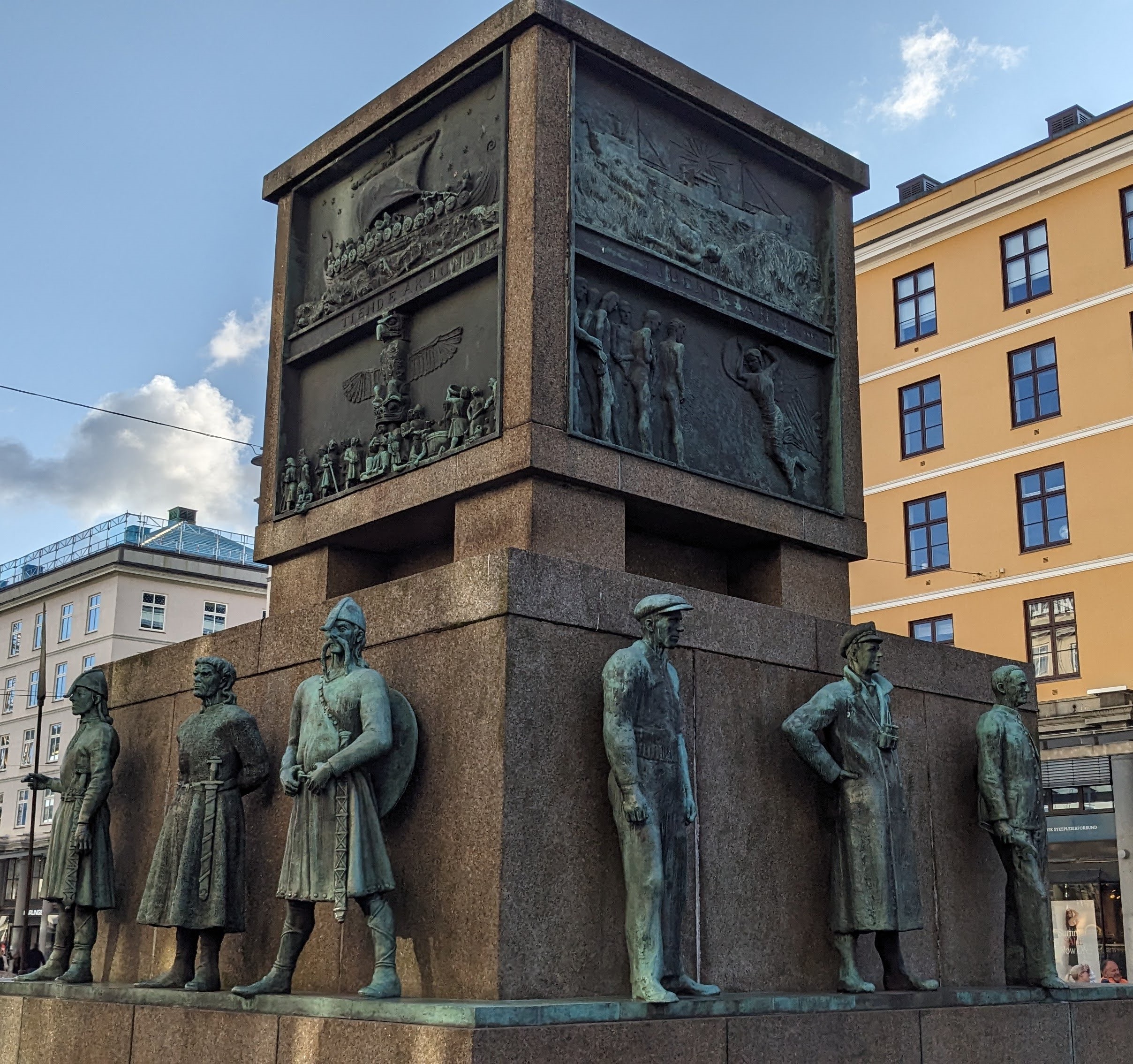 Sjømannsmonumentet (Sailors Monument) by Dyre Vaa, 1950. Vikings and 20th-century seamen are shown on these two sides |
 19th-century whalers and an 18th-century expedition to Greenland are depicted on these two sides of the Sailors Monument |
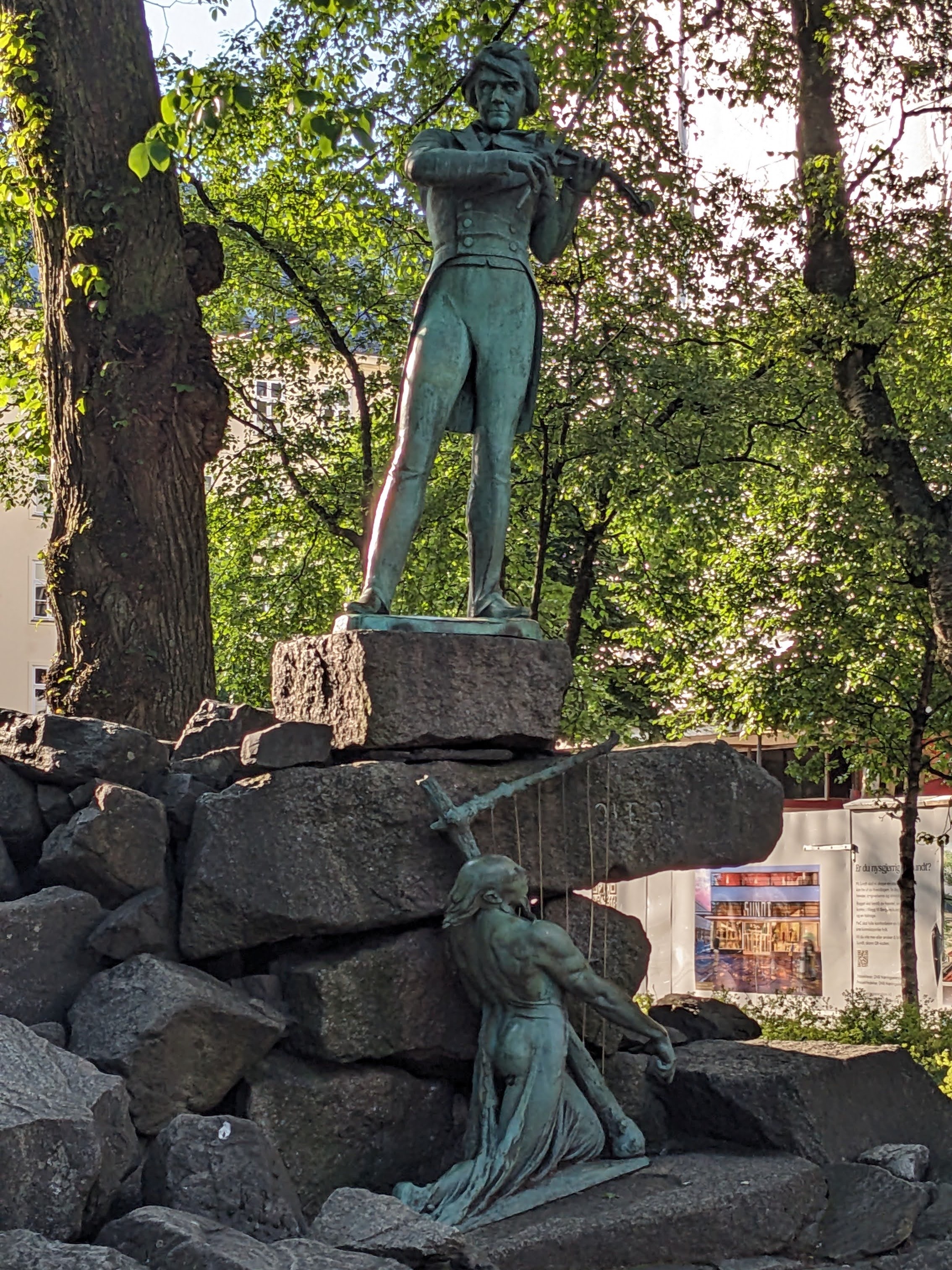 Ole Bull (and skald) by Stephan Sinding, 1901 |
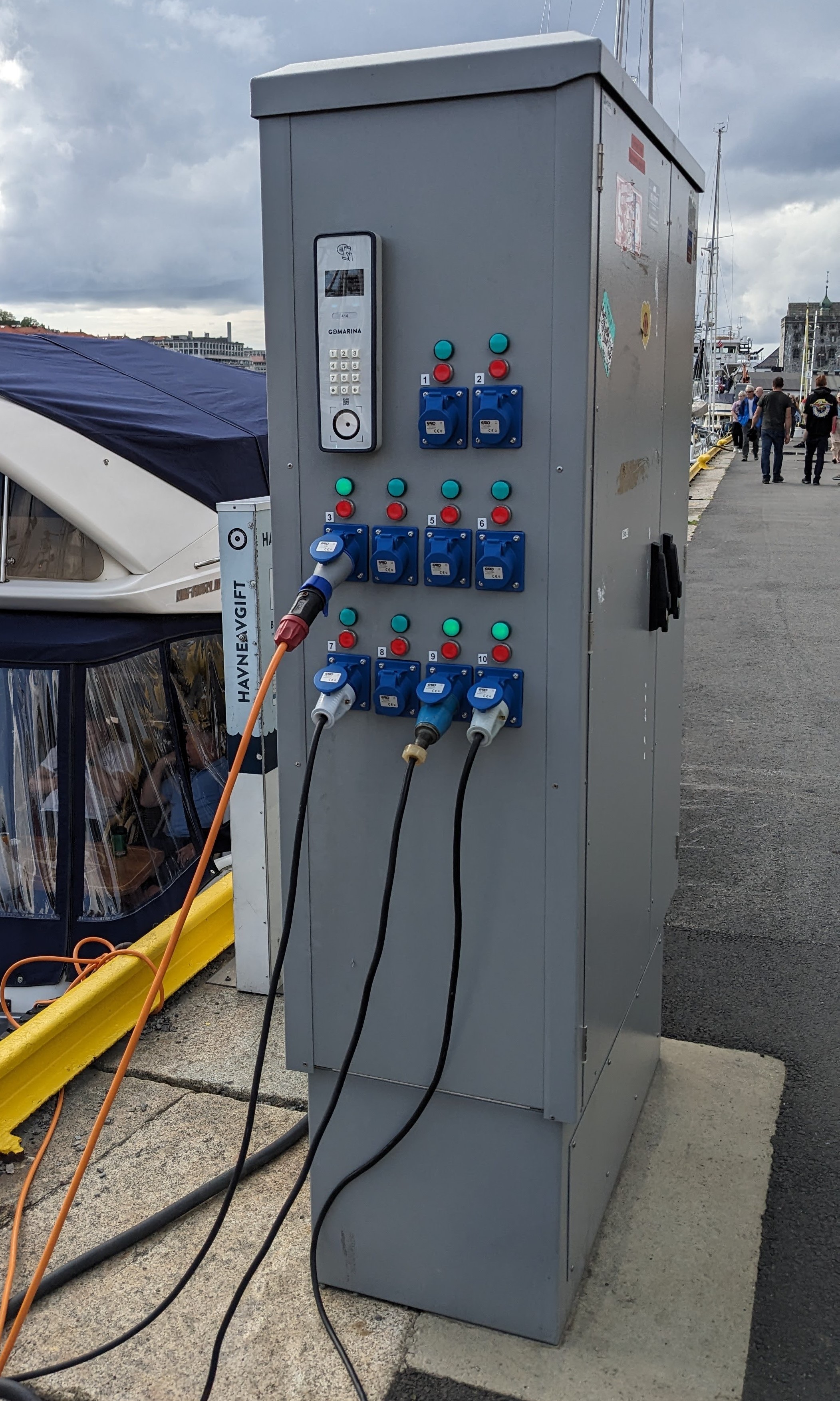 Charging station for electric-powered boats |
Nancy would have loved walking around Bergen for another hour or two (if not until the sun finally set) but we needed some wi-fi time before we went to bed, so we headed back to the hotel about 8:15 p.m. Soon after we got connected to the Internet, we got a call via Facebook Messenger from two of our grandchildren, letting us know that they had just arrived in Cincinnati. Our son Soren and his family were relocating to our area and would be staying at our house until they found a place of their own to move into. It was fun to know that we could look forward to having them nearby after we got home.
What a wonderful virtual tour! Thank you for sharing your experiences with us so we can also find joy in your travels. Since food is so important to me in my travels I appreciate your description of your meals also. Happy traveling!!
Your Bertelsen Cousin,
Renee Christiansen
A wonderful virtual tour. Thank you so much for sharing your experiences so that many of us can enjoy your trips as well.
A Bertelsen Cousin,
Renee Christiansen
If I needed/wanted to live somewhere outside the United States, Bergen is definitely a place that I would consider, even though it would mean learning Norwegian. (I could do that, right? Even at my age and brain stage?) We loved the botanical garden at the University of Bergen and St. John’s Church. We also took the funicular to the top of the mountain and enjoyed the view and walked around the trails there. (We’ve been there twice, in 2018 and 2022.) So glad you got to take the “nutshell tour” and look forward to future installments. If the celestial kingdom looks like Geirangerfjord, I will not be disappointed.